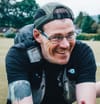Wild Horse 200 - DNF Report
This time the wild thing did not make my heart sing.
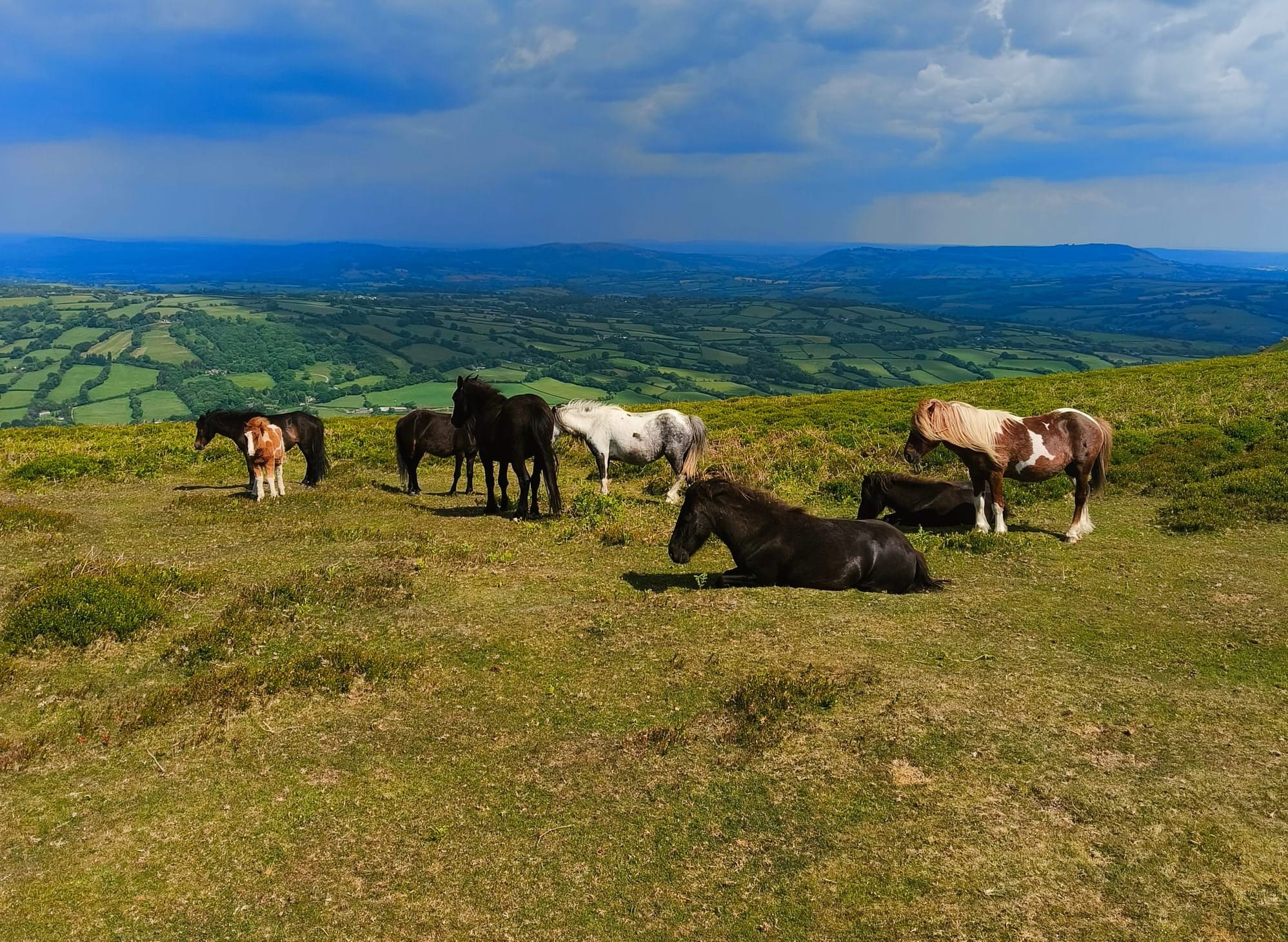
After 6 months of anxiety inducing obsession, my target race for the year and biggest challenge to date had arrived, the Wild Horse 200.
For those unaware: the Wild Horse is a 200 mile point to point race that begins in Chepstow, goes over the mountains of South Wales (Black Mountains, Brecon Beacons, Carmarthen Fans) before stretching to the edge of the Gower to finish in Rhossili.
There are 9 checkpoints in total, ranging from 13 miles to 29 miles apart. In each checkpoint you are allowed up to 4 hours rest, and at three of the checkpoints there are camping beds set up to sleep. You are also allowed crew and pacers if you so wish.
You have from 06:00 Wednesday morning to 06:00 the following Monday morning to complete, a total of 5 days (120 hours).
After tackling the Epona 100 last year this felt like the next big challenge, and being run by the wonderful Stable Adventures group (the folks behind Pegasus Ultra Running) I knew it would be well supported with outstanding volunteers.
The Lead Up
There was so, SO much to think about coming in to this race. You have to be confident all the gear you are using will keep working as the miles rack up, your fuelling and hydration will keep you moving consistently, you have enough layers for different weather conditions, and that you have accounted for the increasing fatigue as the days stretch on.
I really went hard on testing kit, finding the right shoes, the right socks, the ideal set of layers and the right fuel. It became a bit all consuming for a while there and I am now flat broke 😂.
The positive is I did learn a tonne, and had great chances to put what I'd learned to the test during the Hateful 8, CANUM and HOWUM races earlier in the year.
Training
Here's a breakdown of all the training I did for the Wild Horse (click to enlarge). Mileage is running only, in addition I did a fair bit of hiking and the odd short cycle ride.
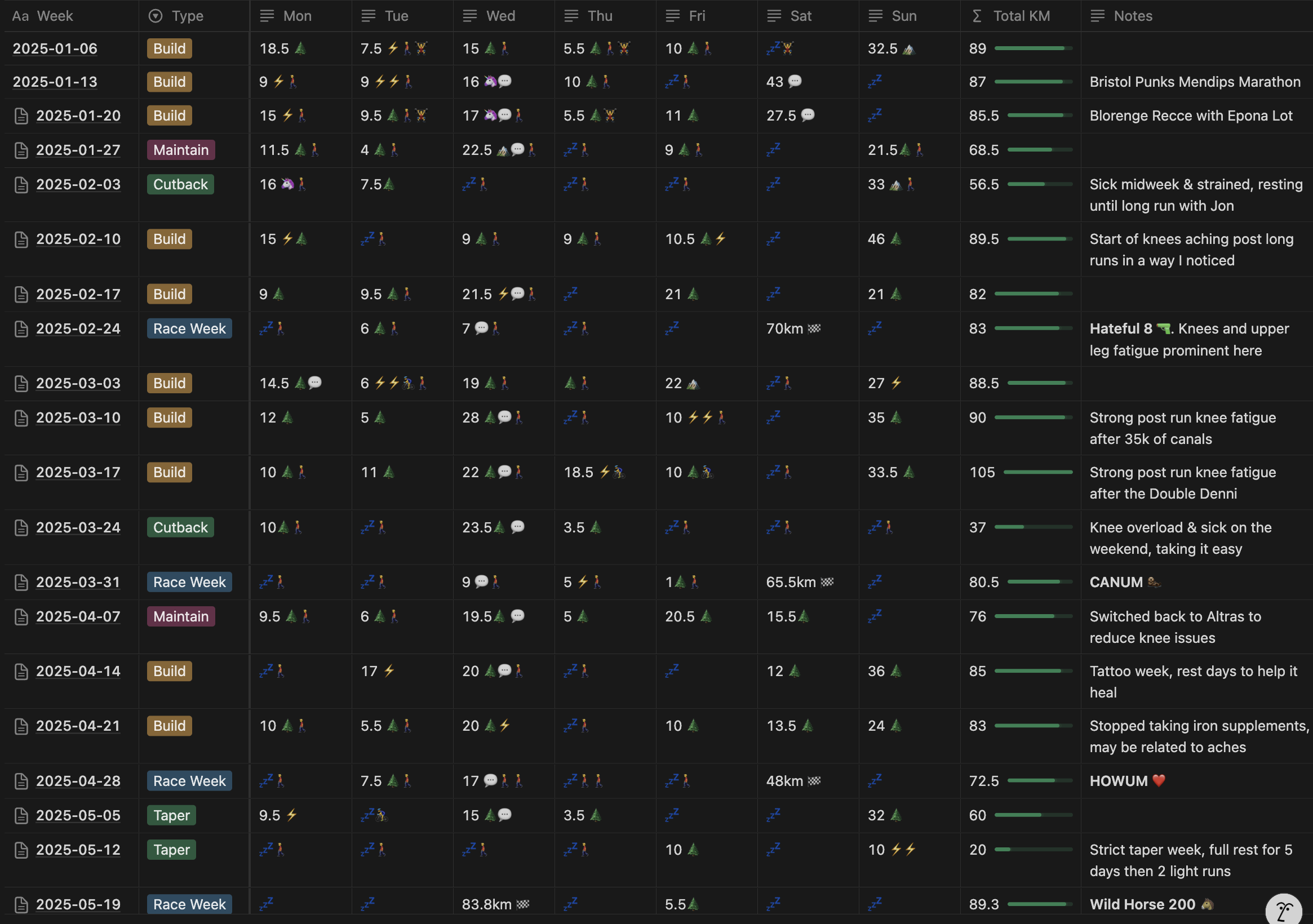
If I could sum up the training, it would be "quantity over quality"; due to the time constraints caused by the school drop/pick up 3 days a week, full time work & family weekend commitments, most of my training was fitting in fairly low intensity work where I could. I did a lot of hiking into the office and run commuting back, but not enough focused sessions like hill reps, intervals, speed work and so on.
You'll also note from the total mileage that I wasn't taking cut back weeks seriously, so a lot of the volume wasn't absorbing properly. On weeks where I did end up running less, I still did too much hiking.
All this lead to getting knee issues about half way through training. Switching to zero drop shoes helped reduce the load on the knees, but if I'm honest I know full well the problem was overtraining. I wasn't resting well, and I wasn't giving myself the space or energy to do good solid workouts.
Caught this 2 weeks out from the event and had a strict taper week, no running for 5 days then light shake outs before race day. This helped enormously and allowed me to feel well rested, healed and confident going into the race.
Carried Kit
Understandably, considering the checkpoints are so far apart, there is a lot of safety kit you have to bring with you in your pack.
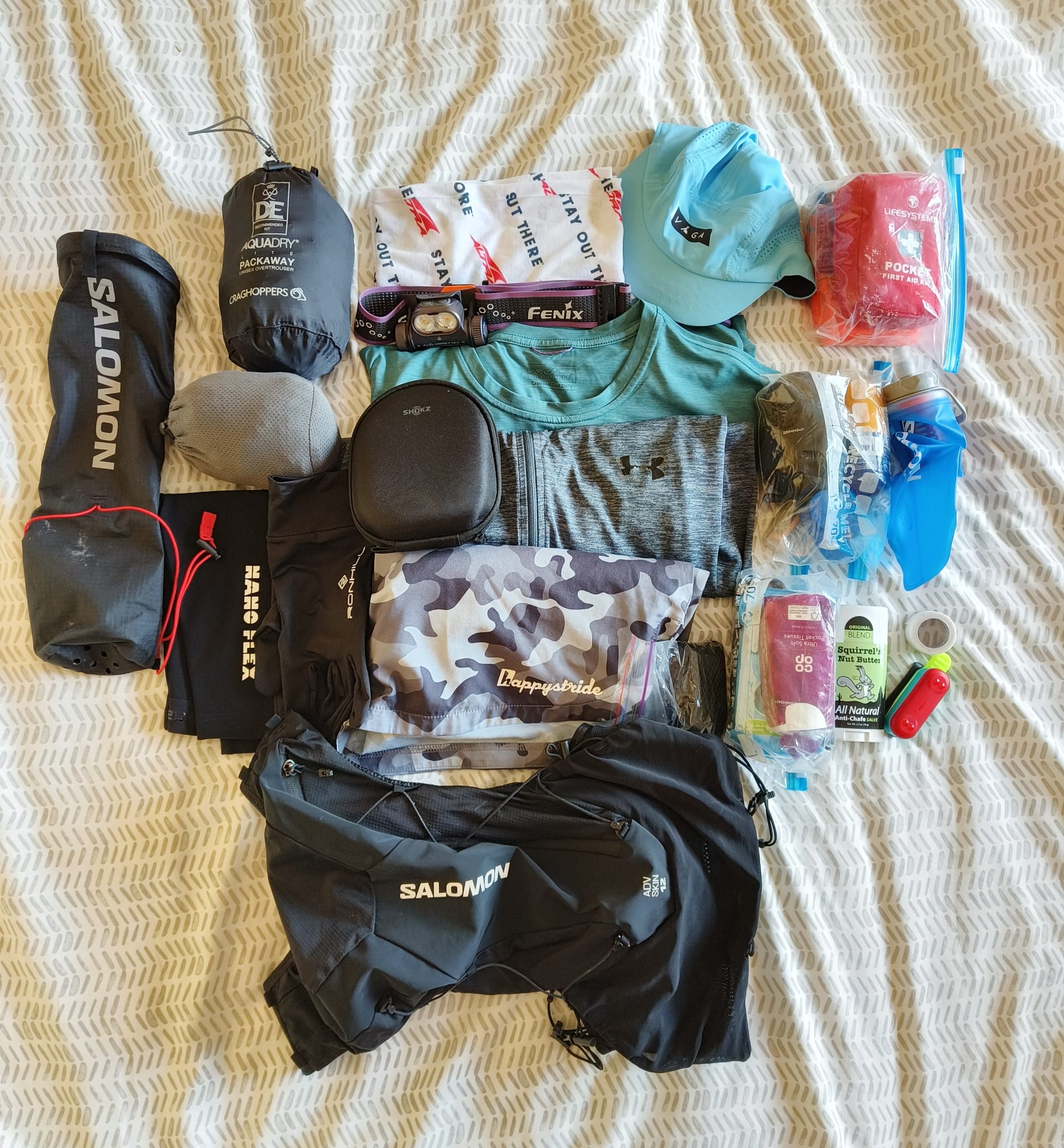
On my person at the start line:
- Vaga Feather Cap: lightweight breathable cap to keep the sun off
- Altra buff: a present all the way from the states to keep me cool
- Patagonia Capilene Cool Daily t-shirt: found this to be really light, breathable and work well in sunny conditions
- Running Punks Mac coat: a water resistant coat as the first day was forecast rain all morning. I had better, more waterproof coats in the drop bag I was saving for when I was suffering from a lower body temp due to fatigue
- Happy Stride Shorts: still the best I've used, comfy, don't chafe, look cool
- Feetures Elite Light socks: a good mix of wicking and light weight, not the most protective of socks but I've found they also leave more room for my toes to wiggle
- Altra Mont Blanc Carbon shoes: I ended up testing a LOT of different shoes, I landed on these as they have a big wide toe box, a generous fit, and a reasonable amount of stack, whilst also being light enough to feel fun and nimble over rocky ground
- A Salomon Adv Skin 12 running pack: doesn't bounce and has loads of space. It was very tight fitting this all in though, and I think a 20 litre pack would have made more sense in the end.
In my running pack:
- Montane Nano packable waterproof coat: basically an expensive bin bag, but it packs tiny, insulates well and keeps the rain off. If I'm in a pinch up the mountains it is a life saver
- Craghoppers Packaway waterproof trousers: these are a bit bulky, and I ended up having to slide them into the bladder compartment of the vest to get them to fit. Very unlikely I'd use them but it's required kit as, if you fall and hurt yourself in the mountains, they will help stop the cold setting in by insulating you well
- Under Armour long sleeve top: fairly basic light top that helps add a little protection if needed, I had better thermal layers in the drop bag I was saving for when I really needed some extra warmth
- 4x 500ml bottles of water with Active Root Electrolite mixed in: opted for this over a bladder as bladders are a) a nightmare to refill at aid stations and b) a nightmare to get back in a pack that is already overflowing with gear. 2 bottles in my front pouches, 1 in the Salomon quiver, 1 in the horizontal bottom stretchy pocket in my vest
- All the food I'd need for the section (see later)
- Fenix HM65R-T V2.0 head torch: great range and visibility, long battery life, fits nicely with a boa dial system. Carried a spare battery for this torch
- Salomon XA Filter: a water filter and bottle that packs small, for sourcing water from streams along the way. Essential due to how far apart the aid stations are
- Safety and miscellaneous:
- Antihistamines and paracetamol
- Clip on LED light: no battery in this one, instead it's gyro based and lights up when you are moving. It was required kit to have a red flashing light for night safety
- Compass
- Toilet paper, anti bac wipes and baggies
- Spare buff
- First aid kit, with additional KT tape and a blister kit inside it
- Zinc tape
- Squirrels Nut Butter anti chafe stick
- Power bank and charging cables for my phone and watch
- Roll on suncream
- Harrier Emergency Survival Bag
- A lucky obsidian heart gifted by the wonderful Katja
- A lucky horseshoe charm made by the wonderful Rachel
By this point I don't think there was an inch of space left on my person. When the rain stopped later I had nowhere to put that punks mac, had to go round my waist.
Drop Bag
This had to carry everything I may need over a 5 day period, for whatever weather South Wales may throw at me. I'd also heard that as you get more fatigued your body temperature drops, so extra dry layers for later would be essential.
Our drop bags would be available at every aid station.
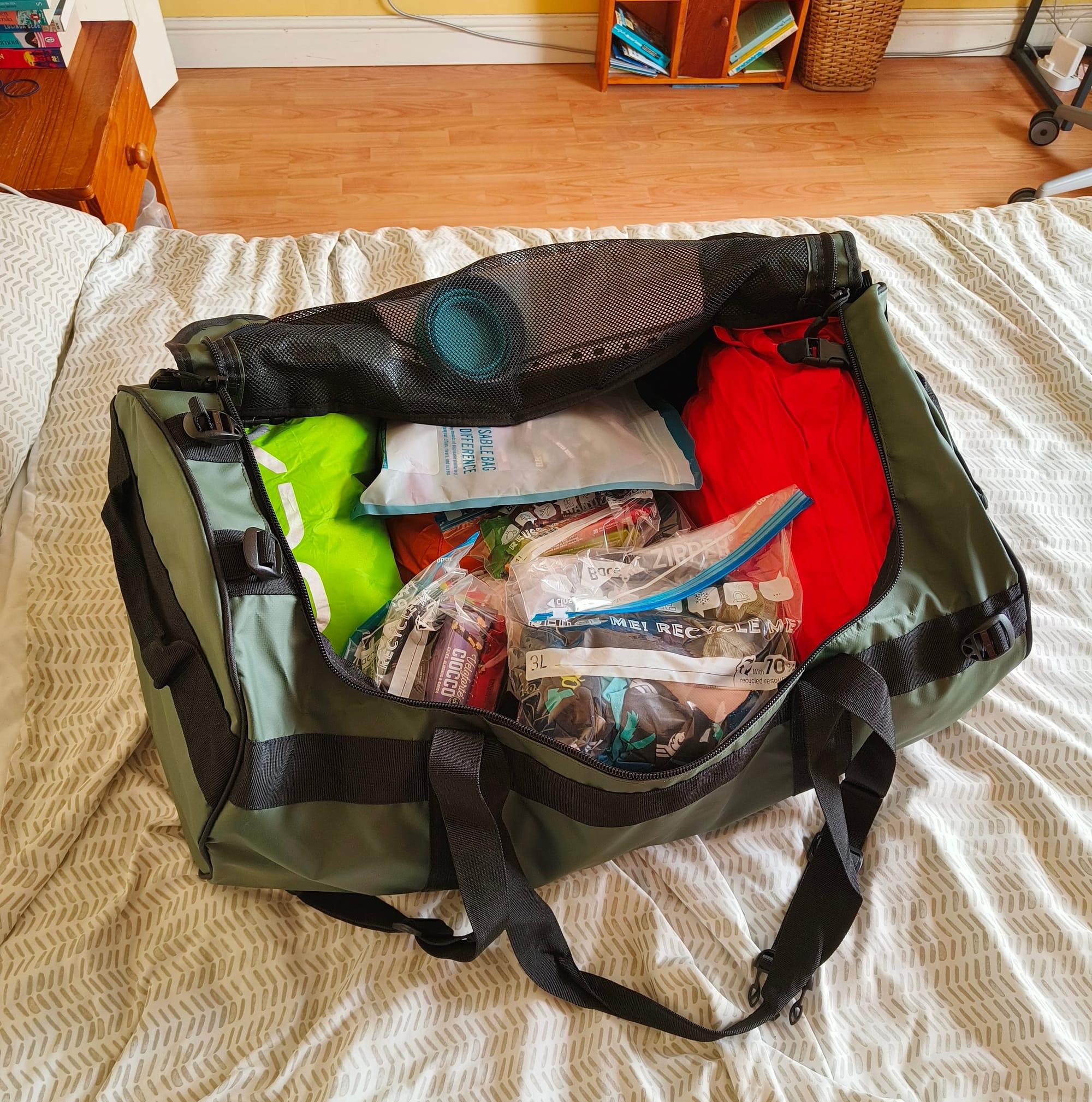
In the bag I had (deep breath):
- A hand written checklist of the things to do at each checkpoint: as exhaustion sets in this would be useful to remind me what I'm meant to be doing
- 3x full changes of running clothes (shorts, t-shirts, warm mid layers, waterproof coats)
- 6x pairs of Feetures Elite Light socks to change at aid stations
- 3x pairs of backup socks (Injini, Bridgedale) in case the Feetures ones were causing issues
- Large blister kit to restock the mini one in my pack
- Harrier Helvellyn Carbon poles for when I felt I needed the extra help with the climbs
- Spare shoes: Merrell Agility Peak 5s and Altra Lone Peak 9+. The Agility Peaks were in case the zero drop Altras were causing achilles / ankle aches. The Lone Peaks a very wide, long, forgiving shoe in case my feet swelled big
- Individual bags of food for each stage to restock, 200 miles worth
- A LOT of electrolyte options (Active Root Electrolite, Active Root Sports Drink, Tailwind, Salt Stick Caps, Salt Stick Chews), 200 miles worth
- Spare water bottle if one of mine broke
- Spare Petzl headtorch and spare battery
- Spare glasses
- Spare cap, buffs & a bucket hat
- 3x anti chafe pots (SNB, BodyGlide)
- Alcohol wipes
- Sleeping bag for the sleep stations
- Towel
- Bear Hug knee supports in case my knee niggles came back
- Spare arm warmers
- 3x spare gloves of various weights and waterproofing (I get cold fingies)
- Spare toilet paper, baggies, alcohol wipes
- Toothbrush and toothpaste for the sleep stations
- Spare suncream
- Cable ties and duct tape (shoe / gear repair kit, not much you can't fix with ties and tape)
- KT tape, zinc tape
- Eye mask and ear plugs to help nod off at the sleep stations (they are quite noisy)
- Collapsible cup for aid stations
- Warm clothes for recovery at the finish line and sleeping in if cold
Everything was in dry bags to keep it waterproof in case we got heavy rain at a checkpoint, a mix of roll top dry bags for the bulkier stuff and zip lock bags for everything else.
Fuel and Hydration
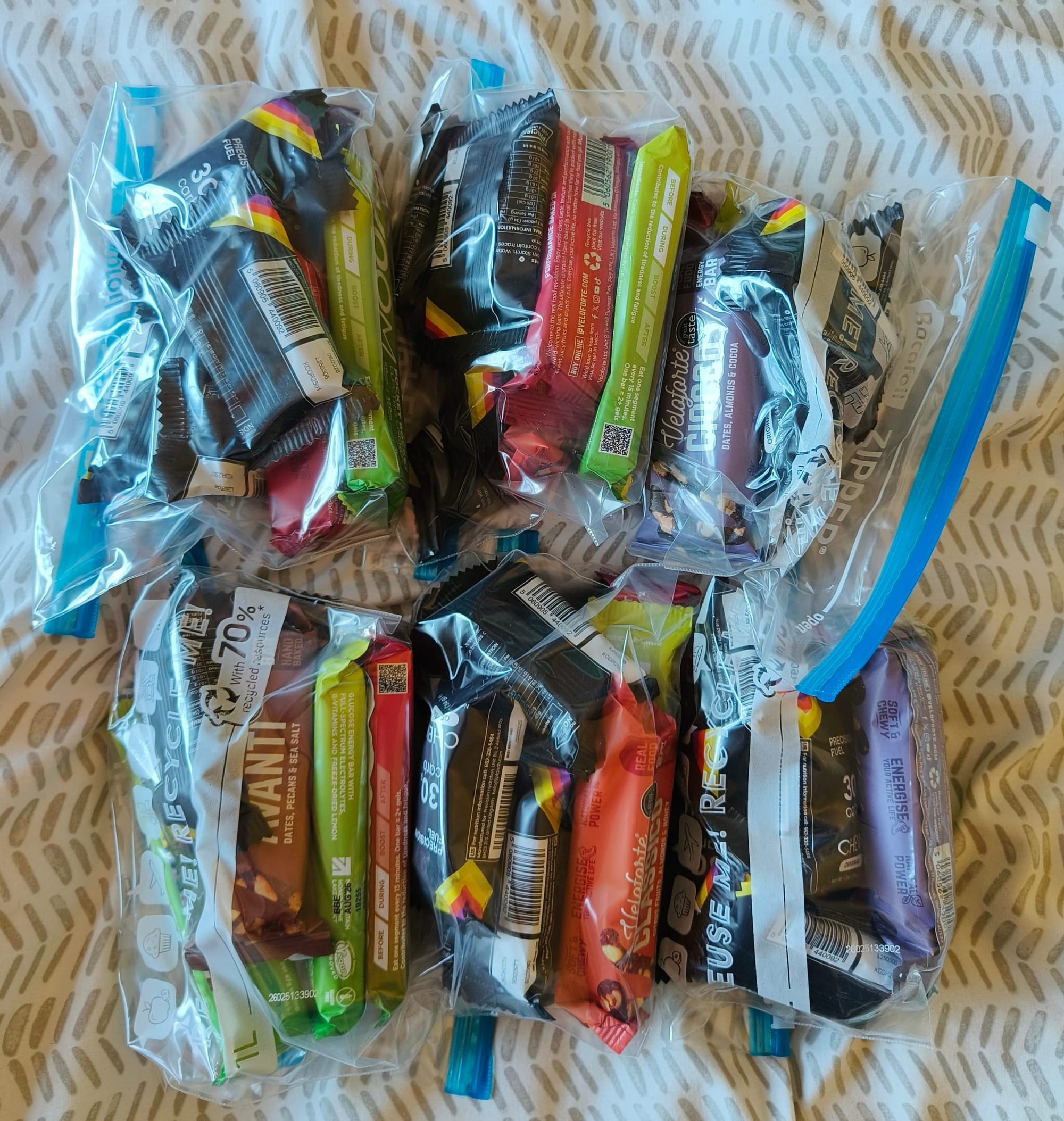
I was opting for simple between checkpoints, then eating more substantial food at the aid stations.
- Active Root Electrolite was my primary electrolyte solution: it's 320mg sodium matches my salt loss exactly and it comes with 8g of sugar so you get a little carbs but it isn't overly sweet. It also has ginger which helps keep your stomach settled
- I had Active Root Sports Mix and Tailwind as a back up, with Salt Stick capsules if my stomach turned on the sugary tasting drinks
- Food wise I carried Veloforte bars, Voom bars and PH Chews. Voom and PH were the pure carb intake, Veloforte the mix of carbs, protein and fats to keep my stomach feeling fuller.
Logistics
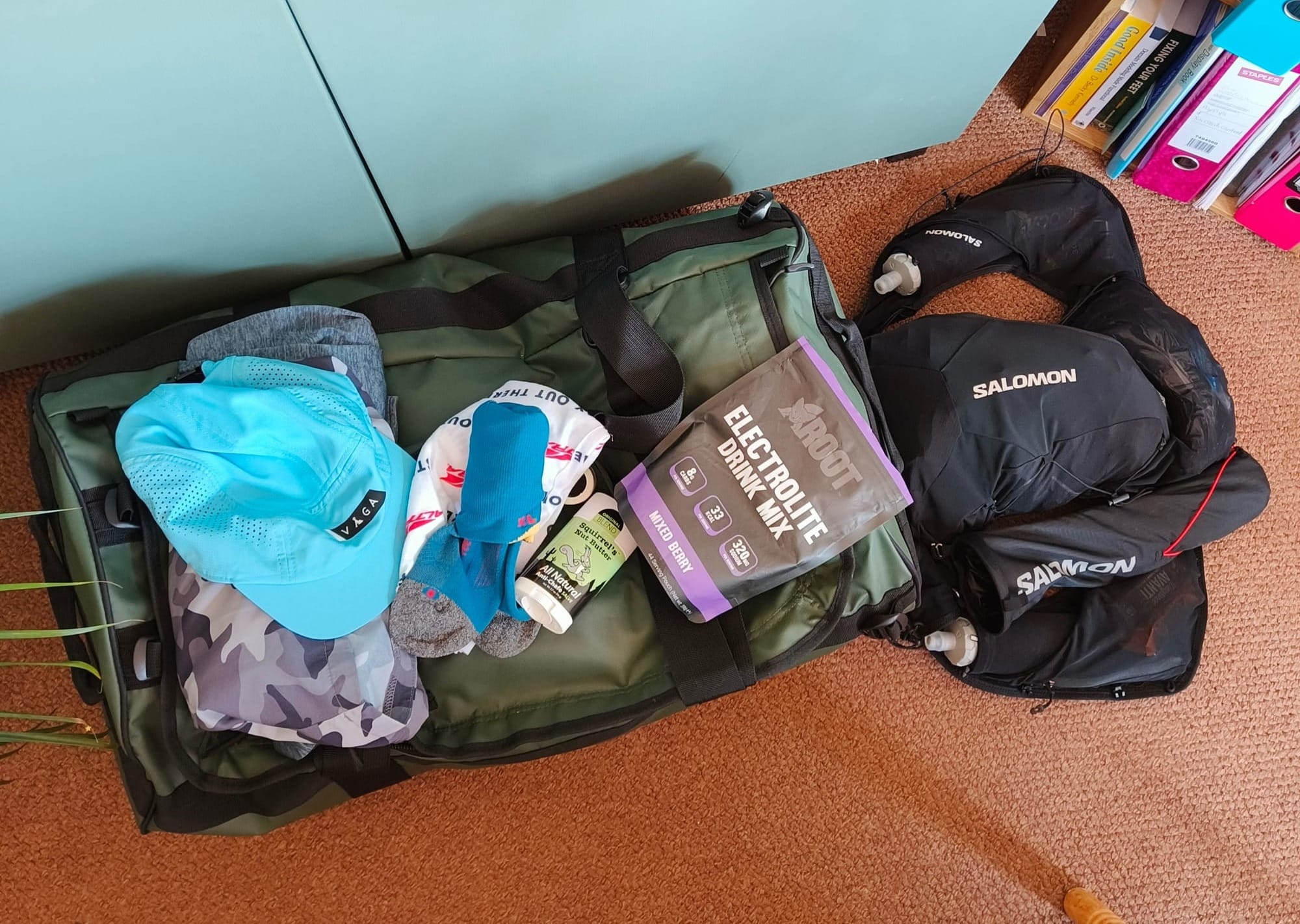
As it is a point to point race there is the small matter of getting to the start and getting back from the finish.
The plan was my partner and kids would drop me off and wave me off the start line, then I'd coordinate with them as I approached the finish line. I was aiming for a late Saturday / early Sunday finish, and the ideal would be my family could pick me up on Sunday and, weather permitting, we could hang on the beach for a bit for the kids.
If I encountered problems Wed/Thu/Fri and needed a lift home things were a little trickier: Zoe would be either at work, or looking after the kids (yes this is foreshadowing).
Registration
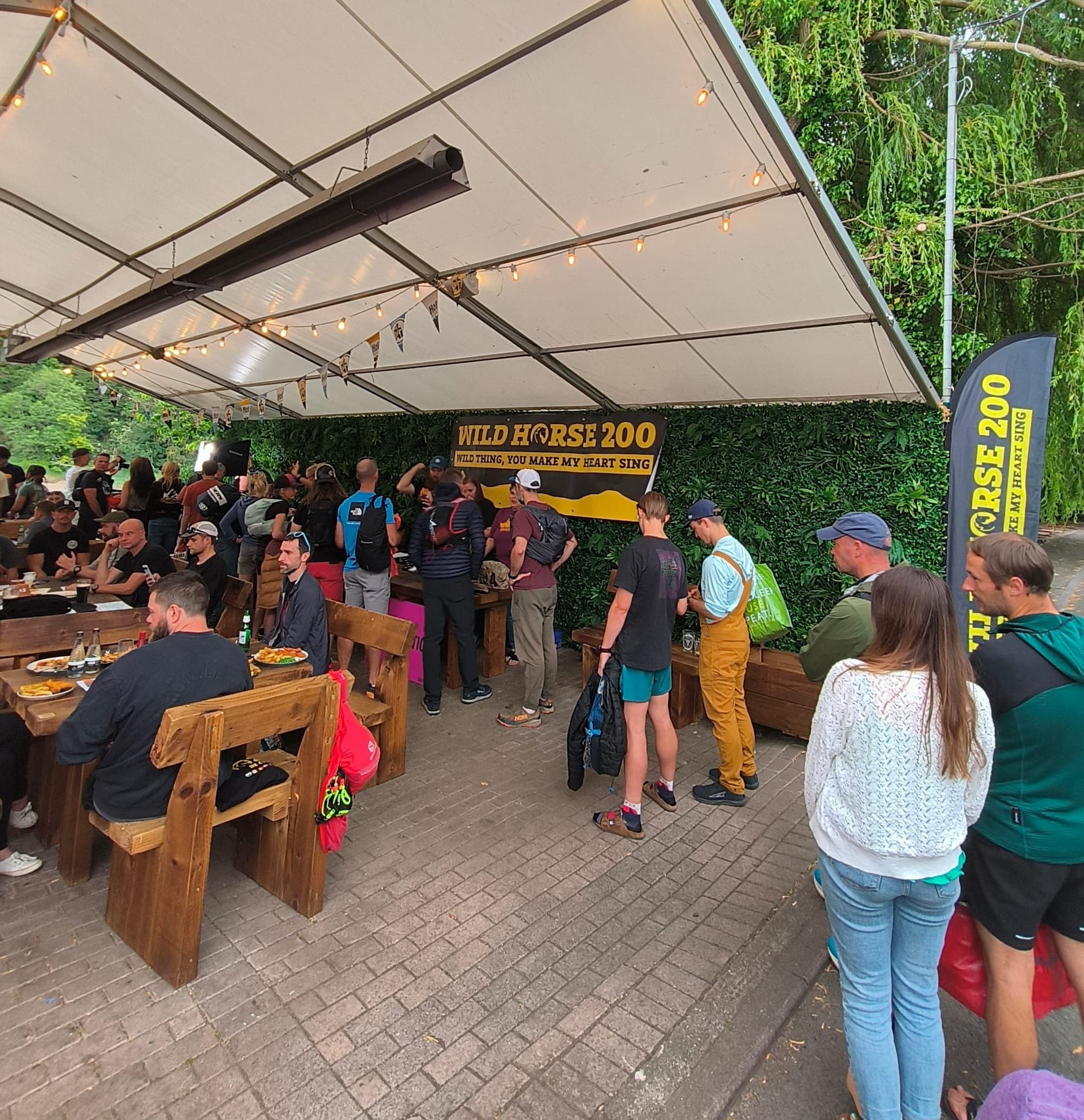
Registration for the event was in Chepstow the night before the race so we could get kit check out of the way and arrive a little later in Chepstow the following day.
There was a queue of participants, 100 crazy folk taking on the race this year.
The wonderful Bernie, Aimme, Dean, Rachel, Owain and Nick were on registration duty, with Matt and Daz taking photos, Rhys, Nick and Cerys coordinating.

I was given my race number, a pacer bib, a tag for my bag, a printed memorial map and this wonderful lucky horse charm Rachel had made for everyone.
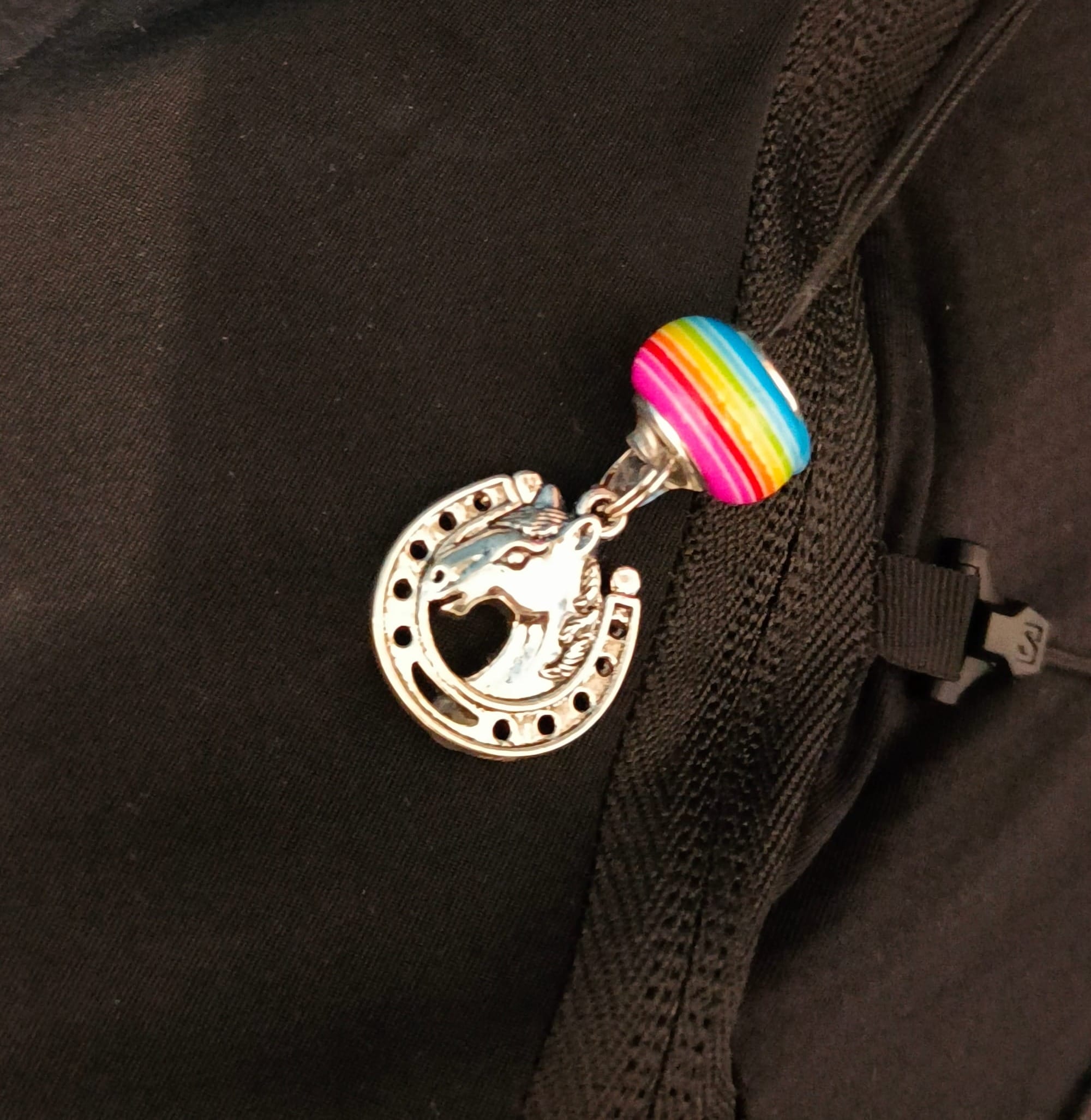
We were also given a tracker to keep us safe and let the folks at home know how we were getting on.
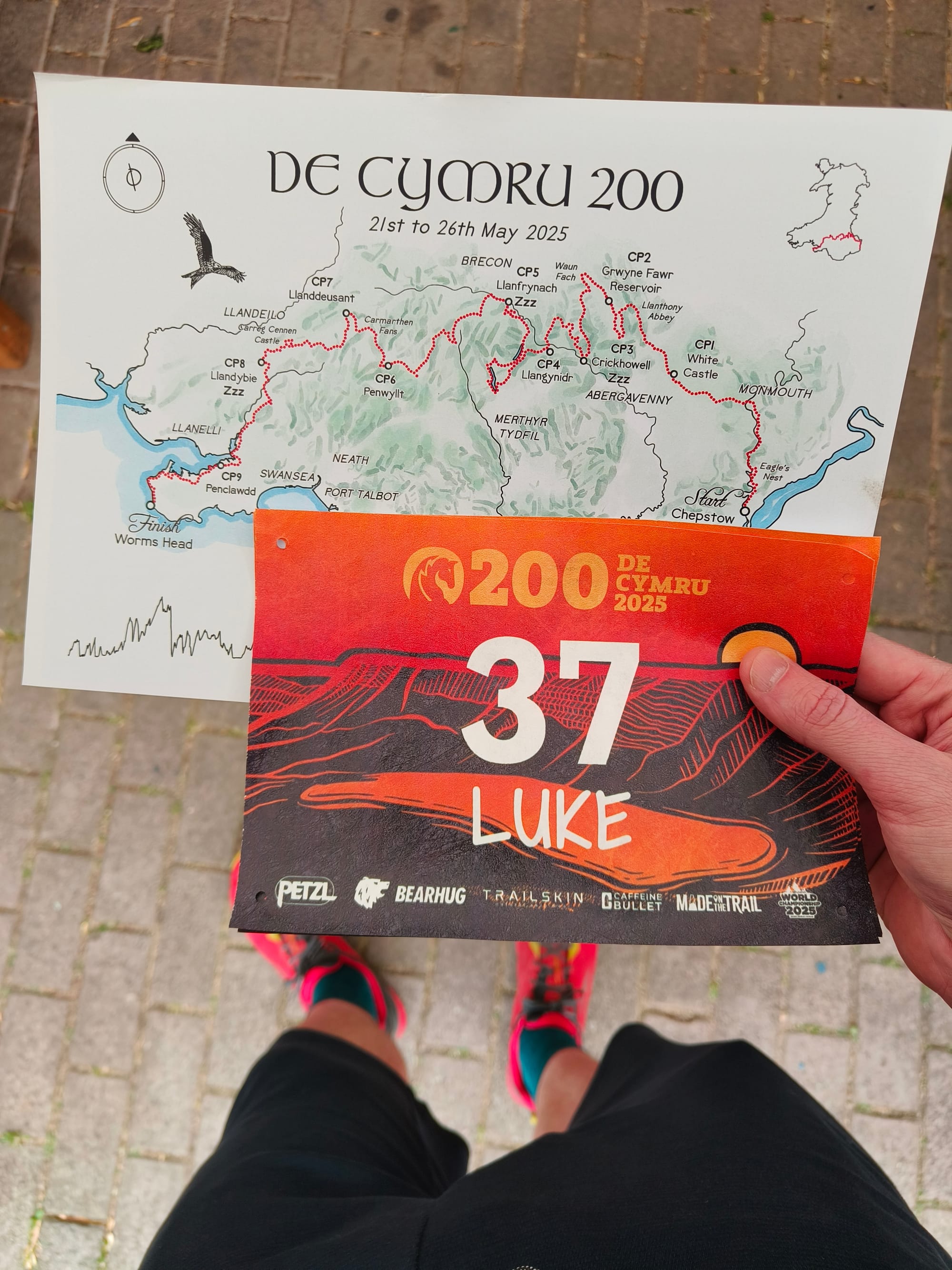
After everyone was registered the race directors Rhys and Nick gave the briefing, before we headed home to bed around 20:30.
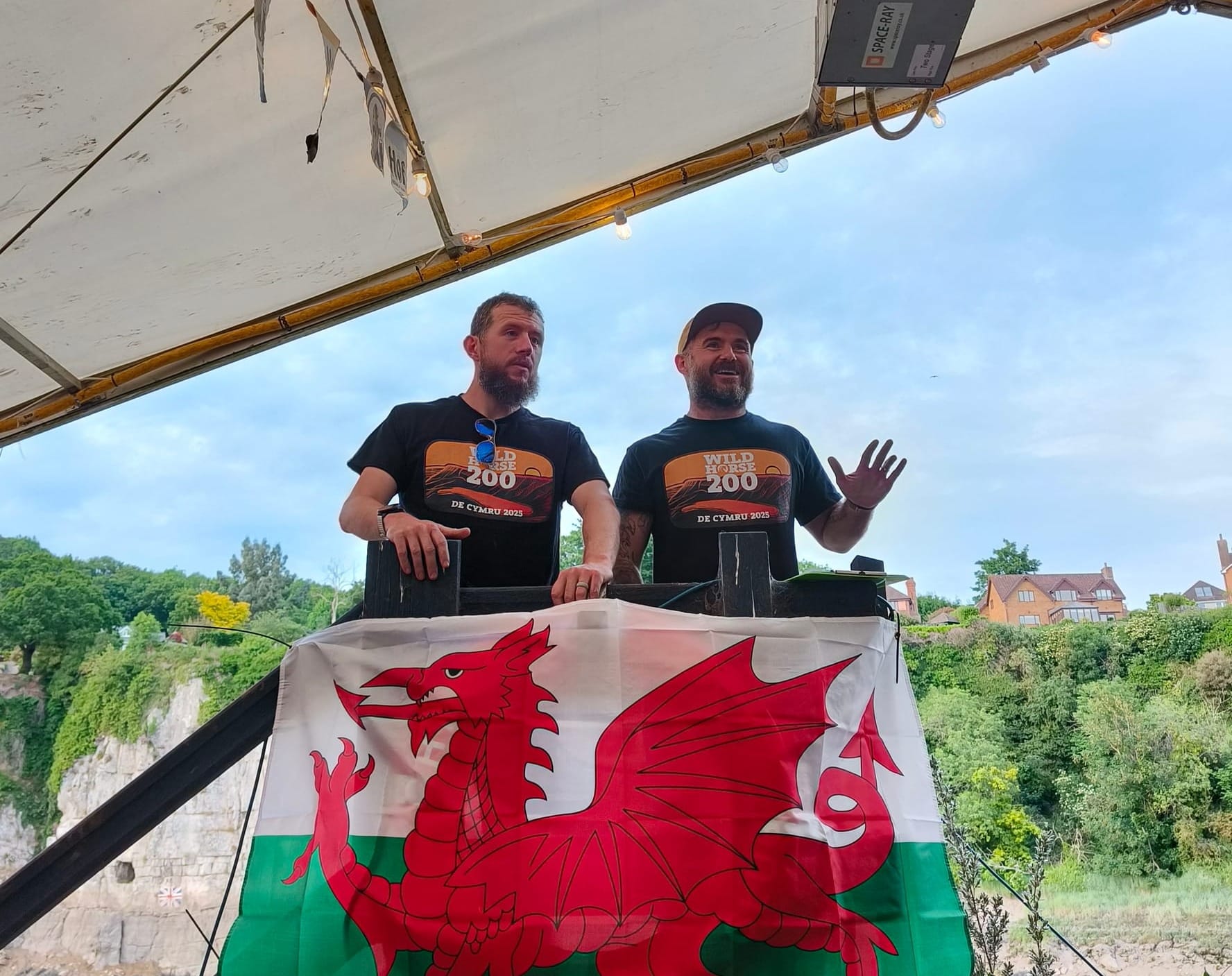
It was great chatting with folks, teasing out some of those nerves and catching up on how we were each feeling.
Race Day
Start Line
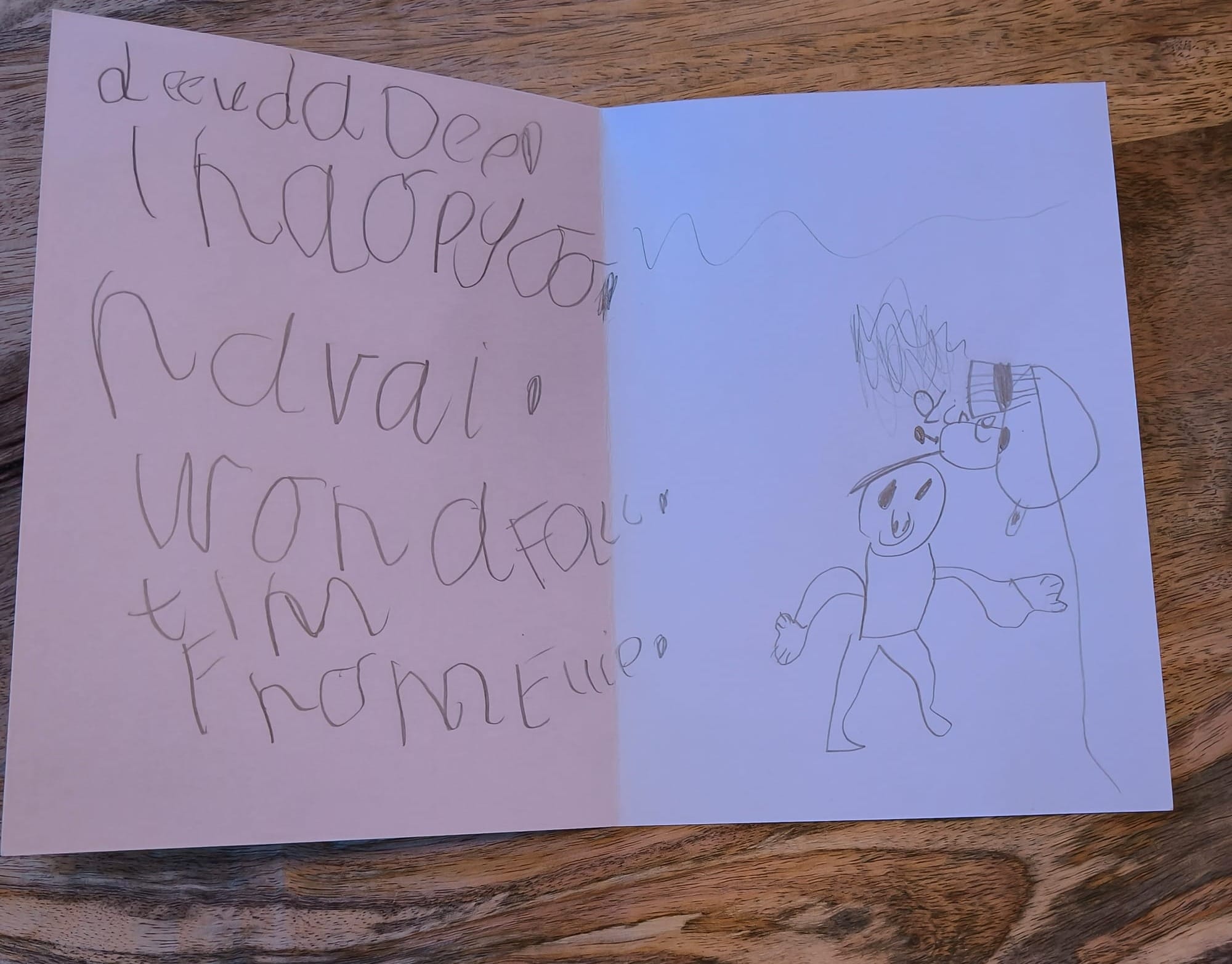
Got up at 03:00 to eat, caffeinate and let my body settle, then got the kids up for a 30min drive to Chepstow.
Ellie had made me this wonderful card to wish me good luck. I'd given the kids a teddy each as a going away gift / bribery for the early start.
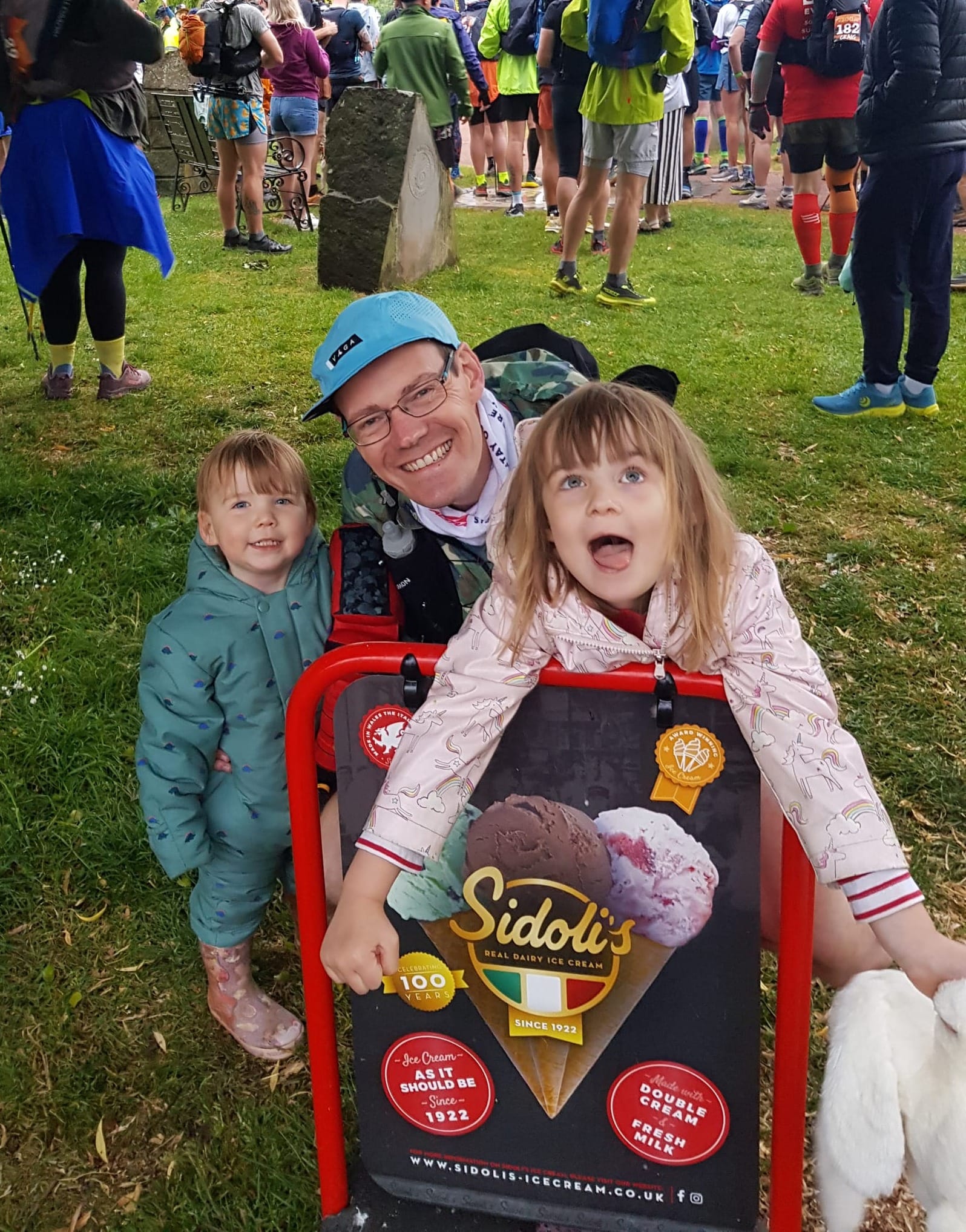
Was wonderful to have Zoe, Ellie and Charlie there to wave me off. I usually go solo due to the early starts and distance to get there.
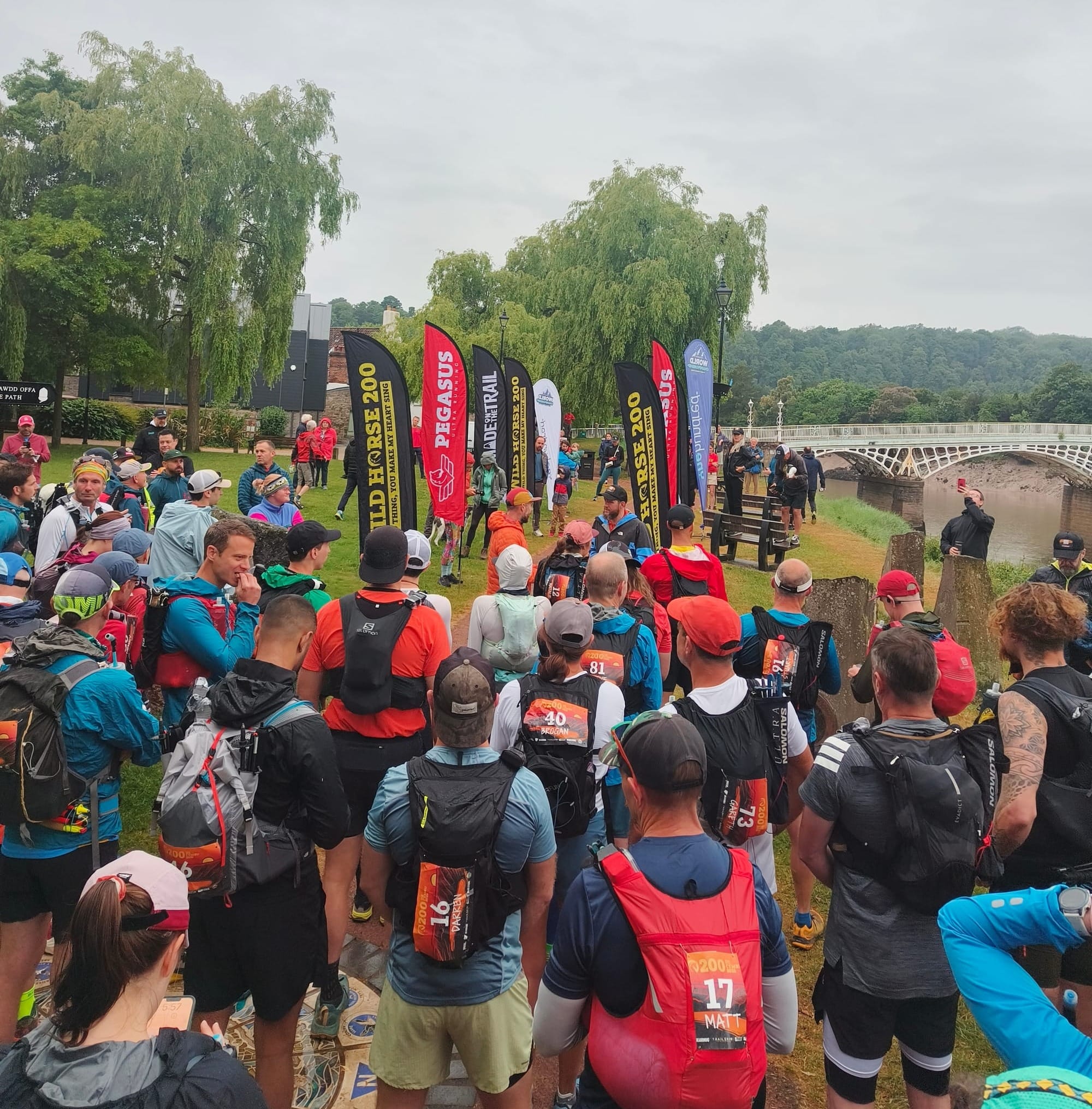
Not much to do but to have Nick activate my tracker, panic over kit choices, go to toilet twice, then line up.
06:00, Wednesday morning, we were off!
Chepstow to White Castle
29 miles to CP1
We started at the beginning of the Wales Coastal Path in Chepstow, before heading into the woods along the River Wye and up to Eagles Nest, then down to Tintern. From there we travelled along the Wye at Brockweir before following the Offas Dyke Path to Redbrook, then on to Monmouth, before continuing along country lanes and fields to the first checkpoint, placed atop a hill with great countryside views.
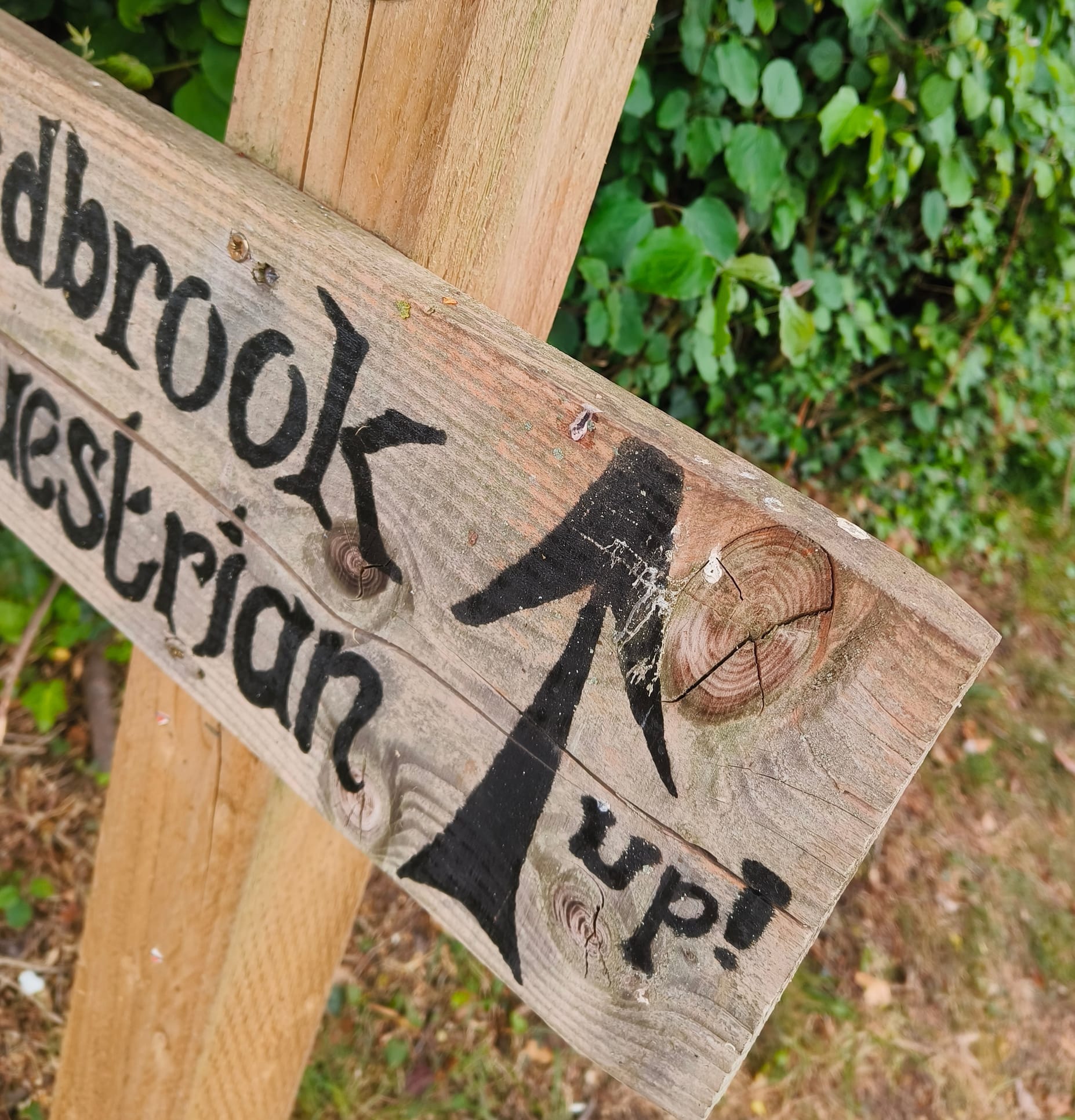
I was really proud of how I treated this section. I took it gently, walked the ups, floated the downs, hydrated well, stopped for extra grub in Redbrook and Monmouth (Greggs FTW), and came into the first aid station buzzing.
On the first stretch I was chatting with Courtney and Charles. Courtney had recently had hand surgery and was running with a waterproof glove to keep the bandages dry, absolute legend for doing the race anyway! Ran a lot with Charles on this stretch, both chatting away and taking it steady.
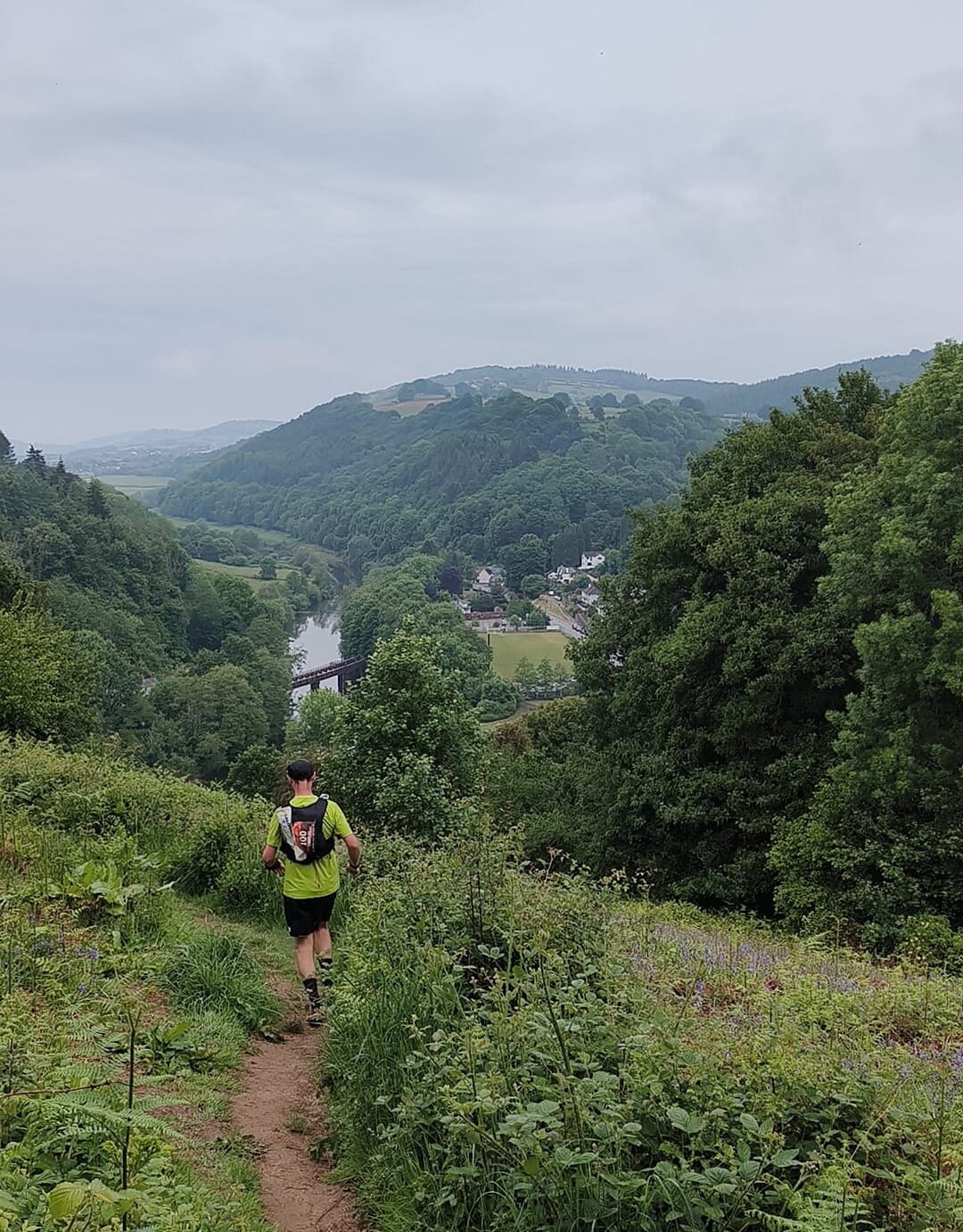
Saw Paul on course doing interviews with runners, we ran together for a short lush stretch of Offas Dyke woodland whilst he asked some questions.
Saw Rachel and her good doggie. She was Cath's crew but would end up cheering lots of folks on around the course.
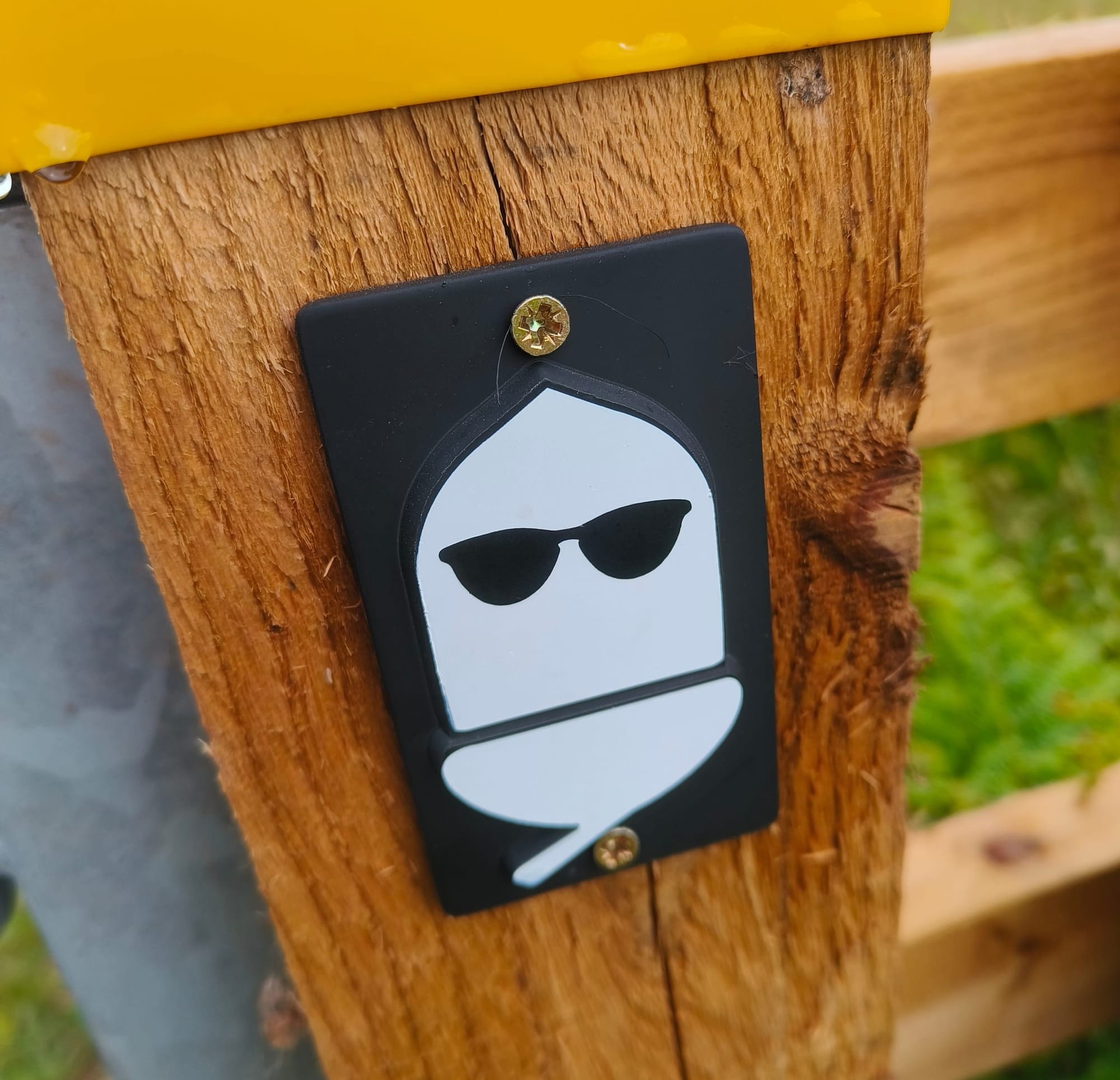
For the first half of this stretch it rained, though the temperature was good so it was refreshing. The second half the sun came out and started to warm the day.
At the aid station I changed my socks, my toes already a little macerated due to hours of wet grass. Got some suncream on now the day was hotting up, refilled my bottles and food supplies. Ate some food and drank about 500ml of liquids (coke and squash). Got my bucket hat on too.
Kaz and Owain were here helping runners restock and getting bottles filled. A big thank you folks 🙏
Here's where I made my biggest mistake, I refilled my bottles with plain water and no electrolytes, I also forgot to take any in my pack. In my head I was thinking it's getting hot and plain water would go down better, and I'd be at the next checkpoint soon. I was a little air headed already here, I nearly left my watch after taking it off to apply suncream!
I think I was on the edge of dehydration when I left the aid station, the warmth of the last bit of that stretch pushing me closer, so when I headed out into the hottest part of the day I got heat exhaustion fast.
White Castle to Grwyne Fawr Reservoir
22 miles to CP2
Leaving CP1 there was another series of field and lane crossings before reaching the base of the eastern side of the Black Mountains. A big climb here onto the top then down to Llanthony Priory, before climbing the other side, descending again the climbing through the Myndd Du Forest to the checkpoint in a remote valley between the mountains.
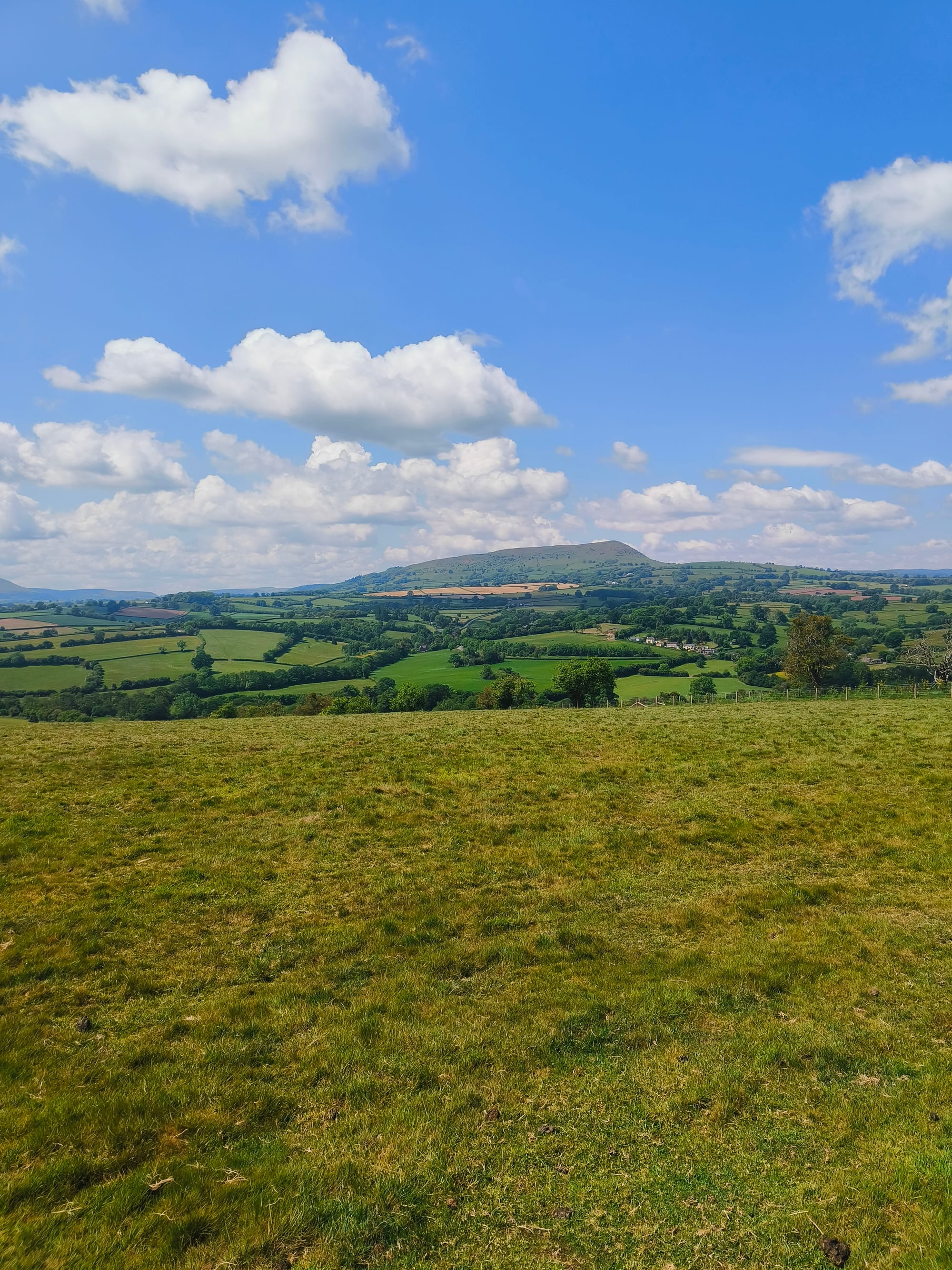
The heat came on strong early, it was above 20c and clear skies, with very little shade on route, especially as we reached the mountains.
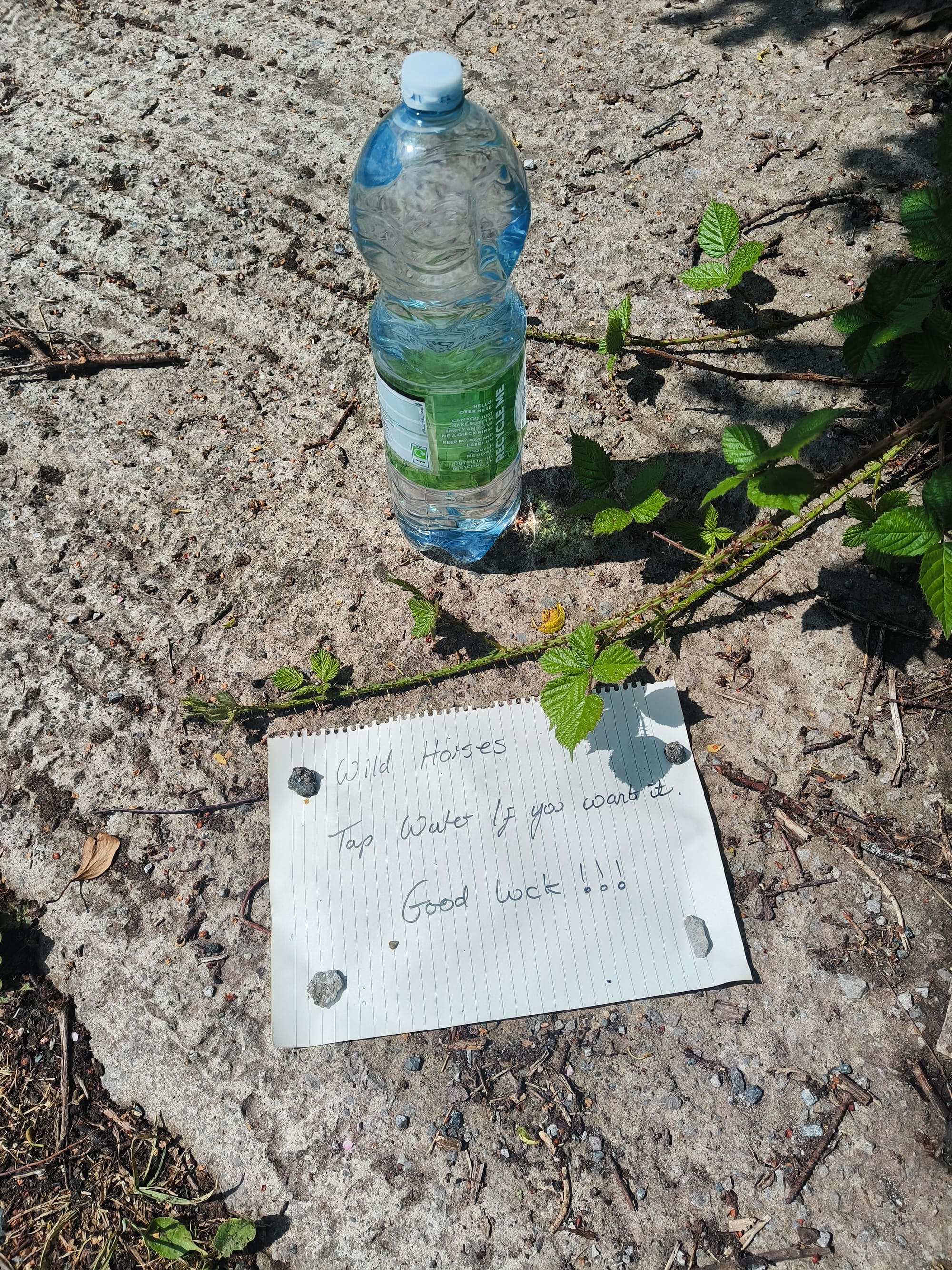
I caught it and did what I'd promised myself I'd do, I slowed down, hiked and focused on trying to hydrate and fuel.
It didn't help though, water and food wasn't going in, I was feeling nauseous. So I opted to continue hiking. The climbs started to feel tough as my energy levels dropped.
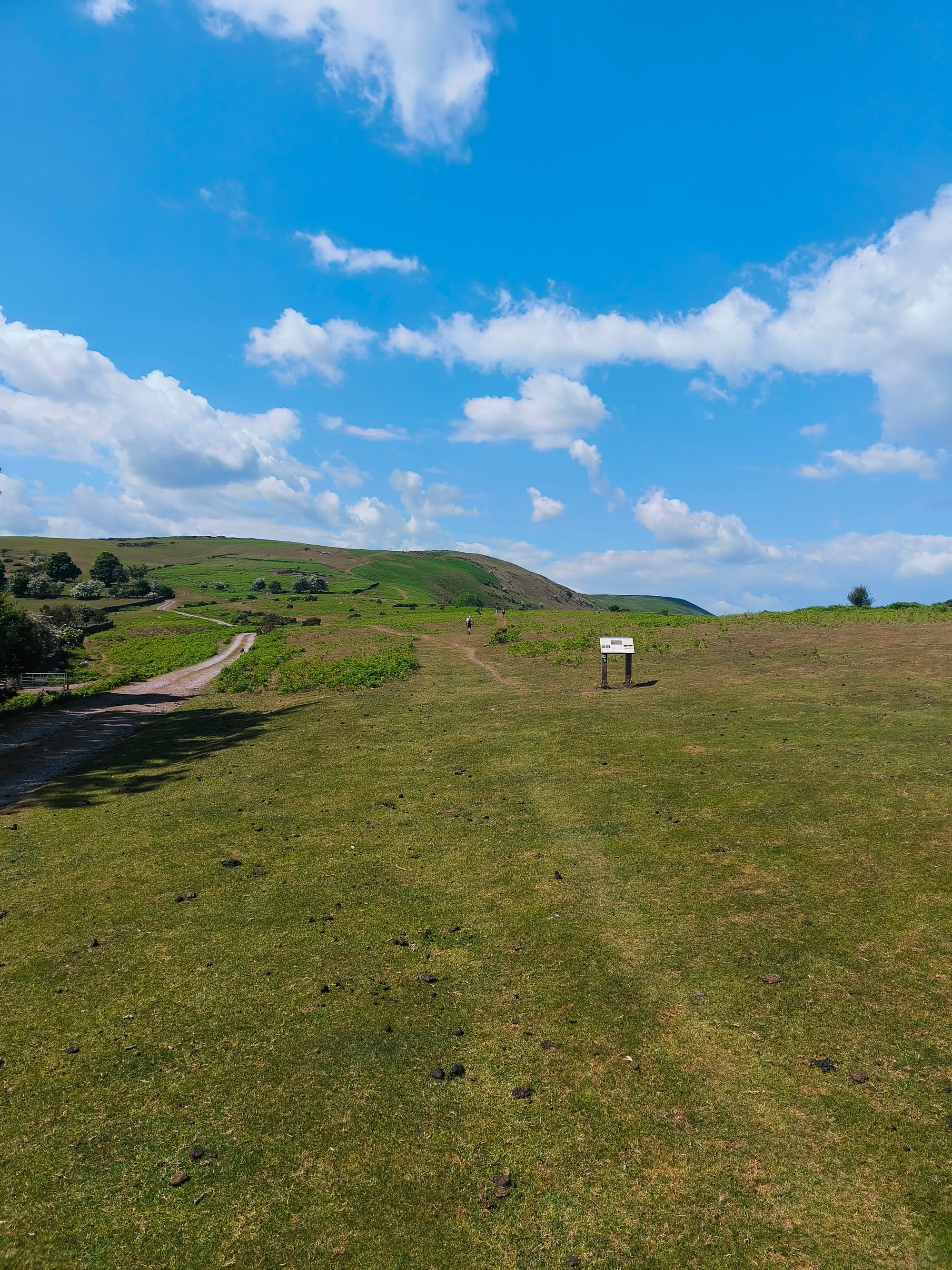
The first big climb was up the east side of the Black Mountains, a long slog. I had to sit in the shade half way and rest. I regretted not bringing poles for this section, they would have helped a lot.
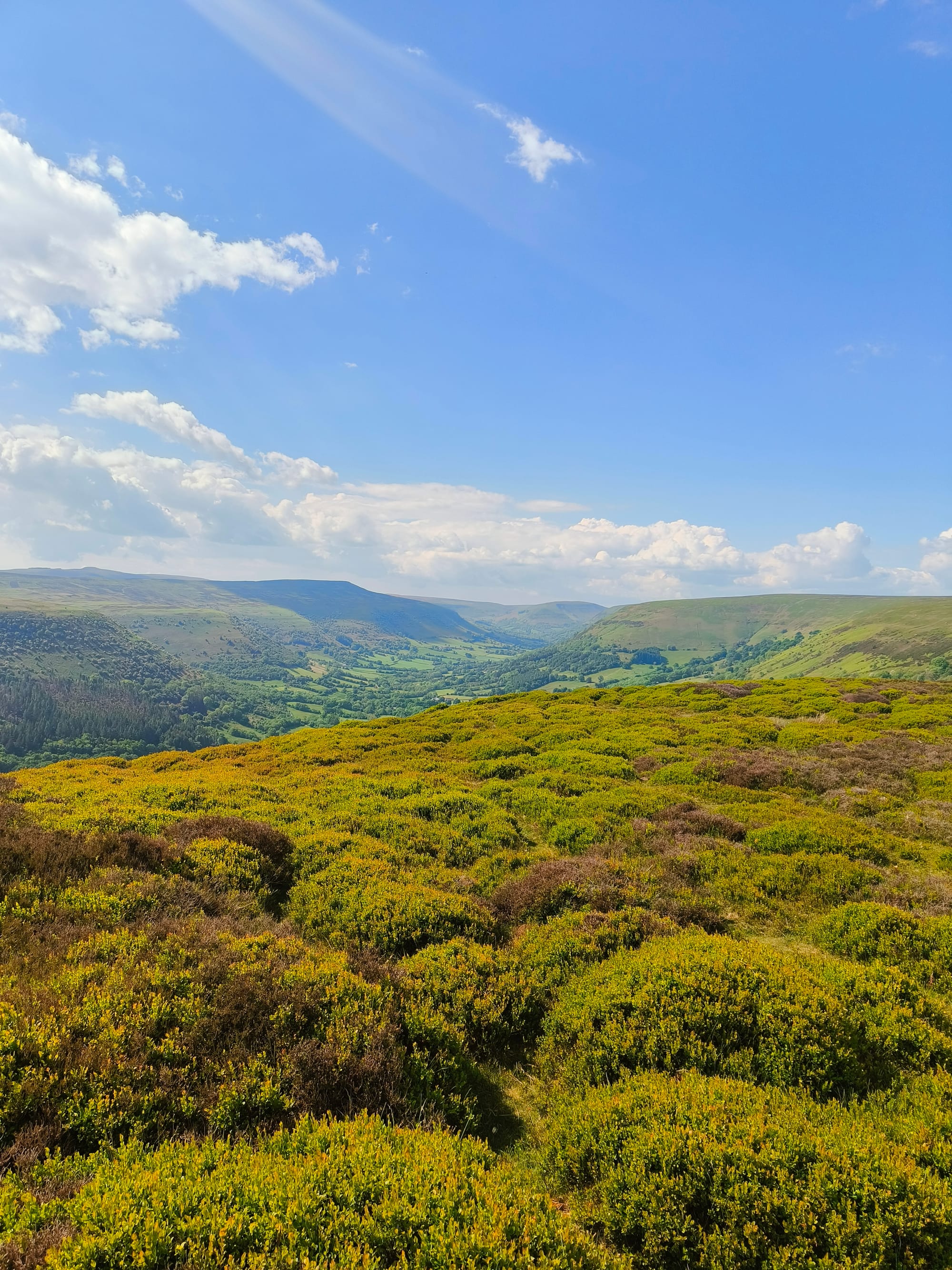
Sure was pretty up there though, clear views for miles!
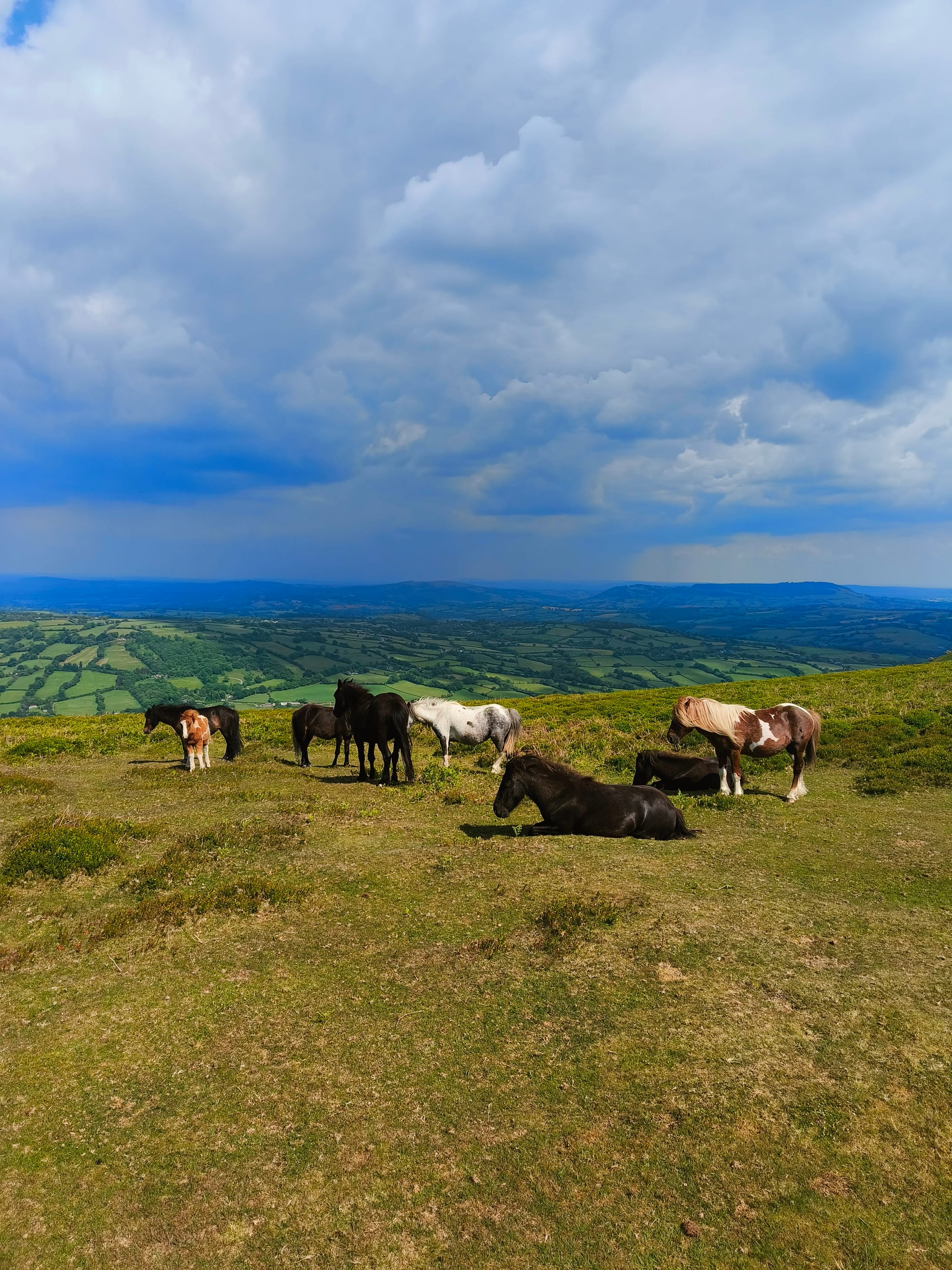
Descend very slowly to Llanthony Priory. A kind soul Janine hiked with me for a bit, gave me a pep talk and a Protein Rebel gel.
Got to Llanthony Priority defeated and faint. Got 2 pints of coke and an ice cream from the cafe and sat in the shade with Janine.
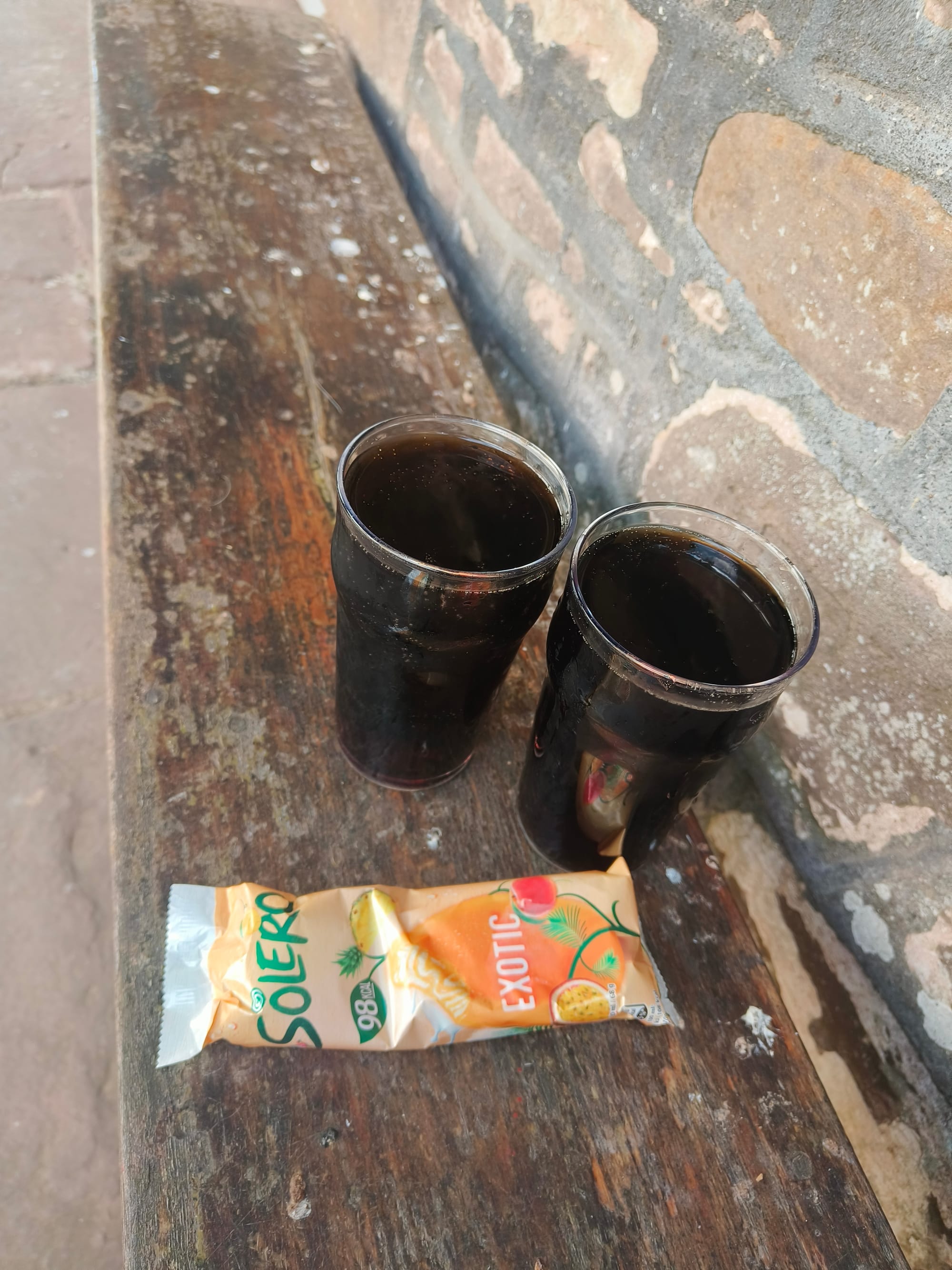
If there was an inch of phone signal in Llanthony I'd have DNFed then and there, but alas I needed to get to higher ground to responsibly call it quits.
Thankfully the coke helped me power up the next climb, as did bumping into the legendary Dan "Slam" Morgan and his friend Jamie. We walked up the steep climb out of Llanthony back up the mountains together, me looking jealously at their poles and wondering what possessed me to leave mine behind.
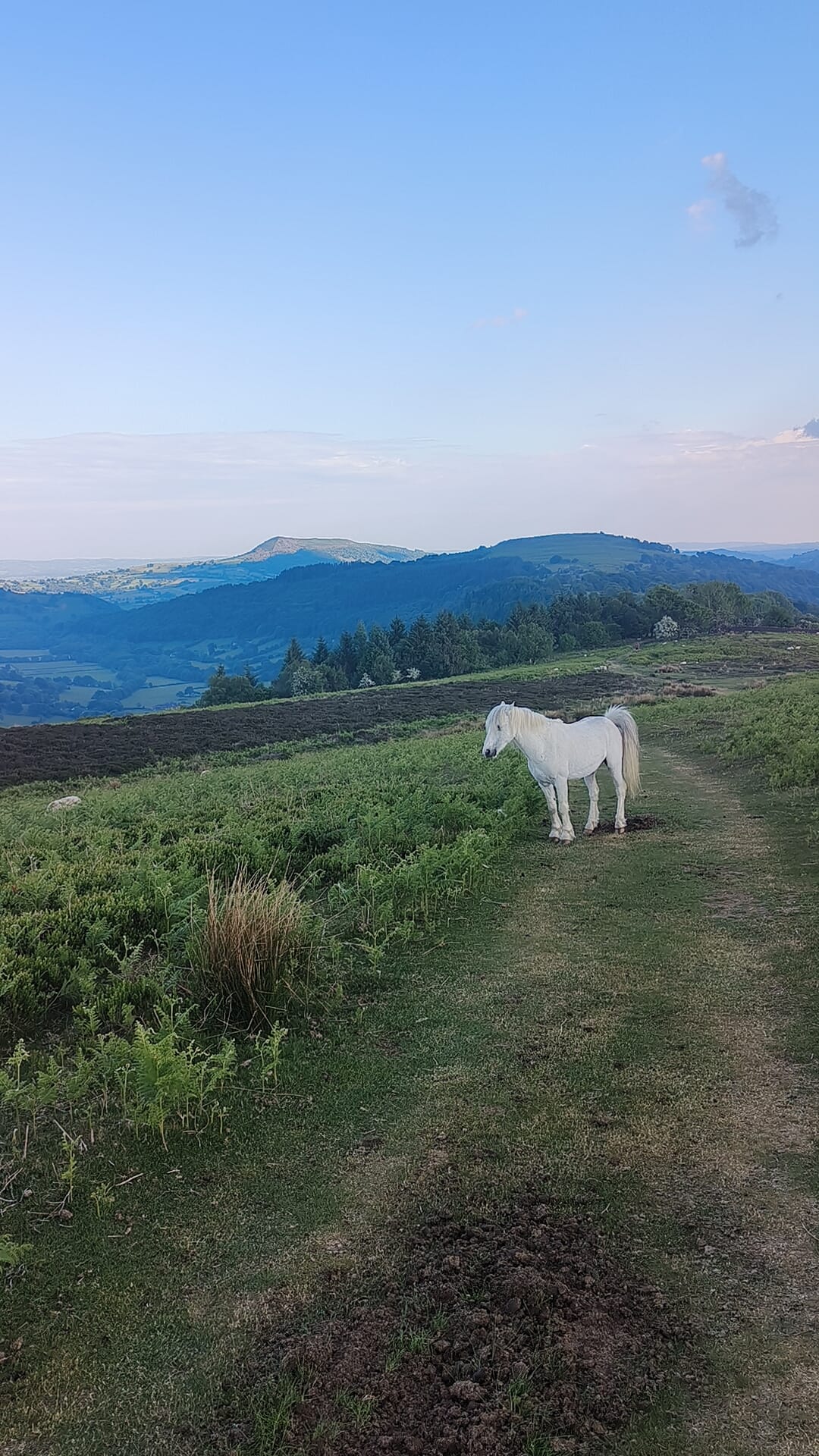
My feet started giving me issues here: my extensor tendon starting to hurt due to the thin tongue of the Altra Mont Blanc Carbons and thin socks I was using. I laced the shoes loose, which then caused a blister to form and my big toes to get bashed due to movement in the shoe.
The remaining slog into the checkpoint felt like it lasted forever, even with the great company of Dan, Jamie and Janine as we teamed up to get it done.
You descend off the mountains to the river below, then back up into the forest, then down to the river again, then back up AGAIN for a long climb, then going over an uneven old trail before finally descending on a hard rocky road to the car park.
The coke had worn off and I felt nauseous and faint here, especially climbing.
Dunked my hat as much as I could in streams to cool me down.
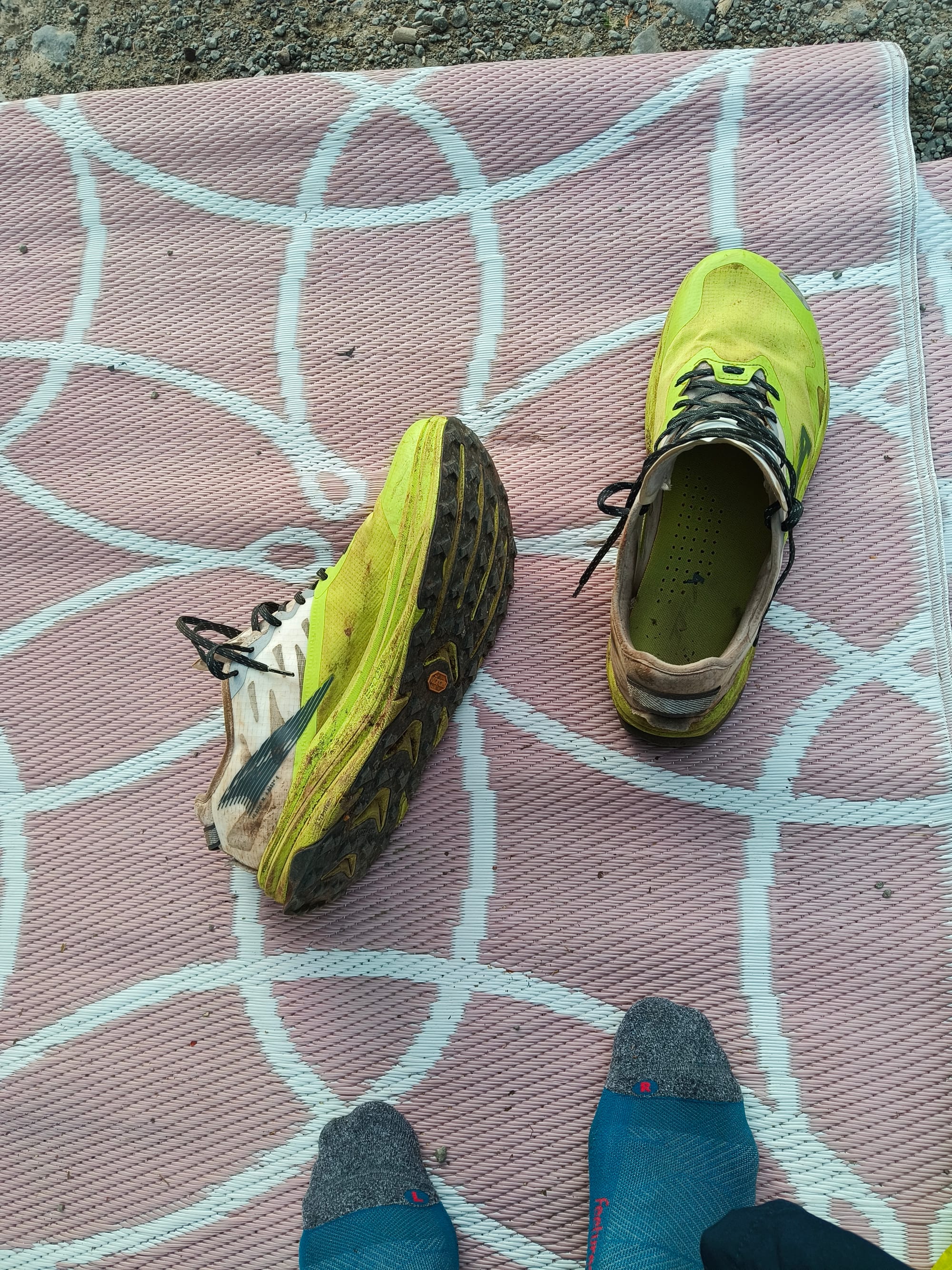
In the checkpoint I saw the medic first, who said, to my surprise, I was hypothermic (despite feeling overheated). He recommended I immediately put some layers on and get fluids in me. He didn't pull me from the race though, would have been happy I continued if I rested well first.
I was done though, my morale totally gone and my "why" long lost to the wind. I had done a 22 mile slog, got myself properly dehydrated, unfuelled and broken, and couldn't fathom doing this 3 more times to get to Rhossili, with those long gaps between aid stations.
DNF
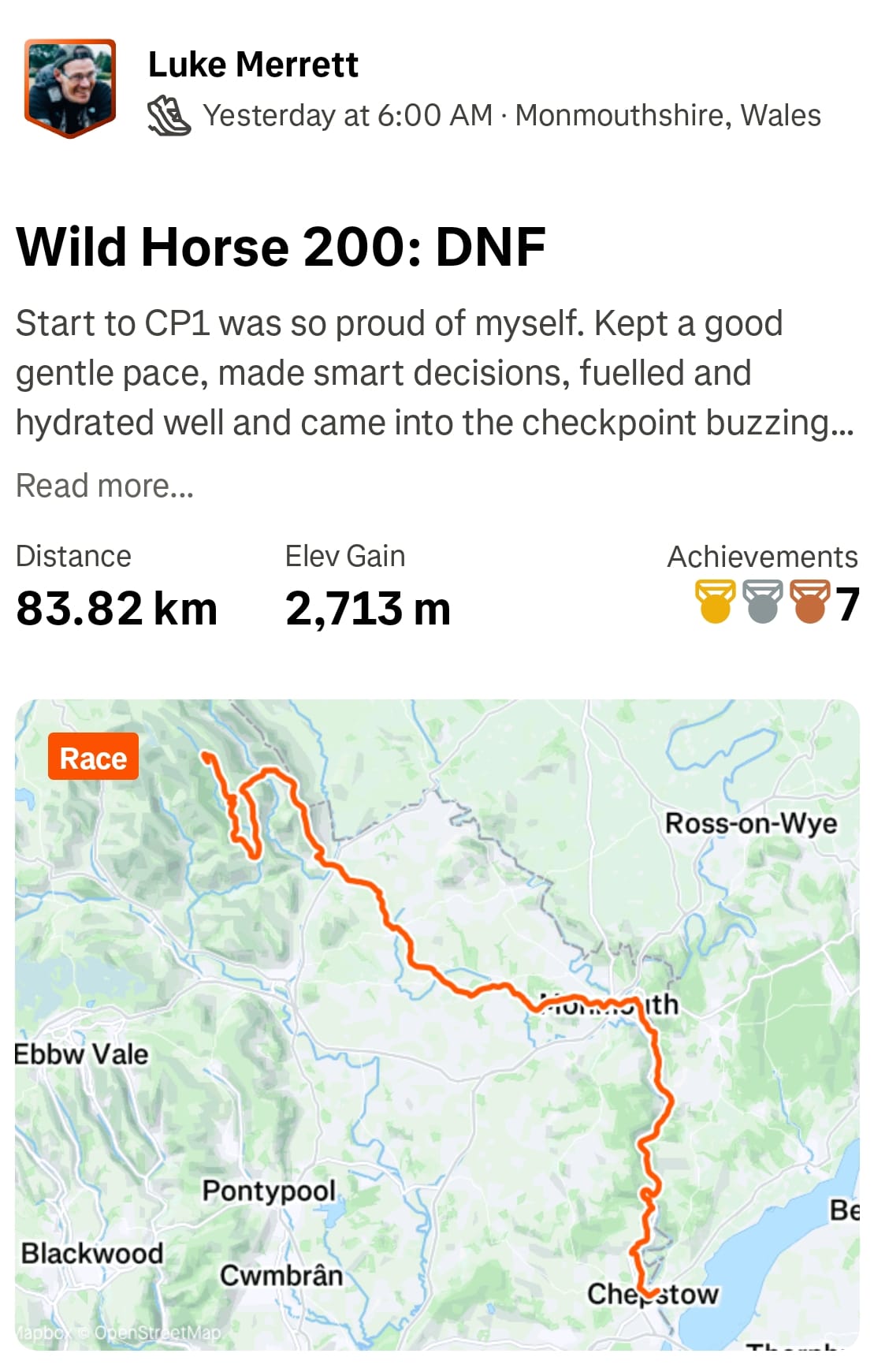
After tearing my tracker off and handing it to Nick, I sat for a bit, recovered a little and got a lift back to CP3 at Crickhowell with Paul.
CP3 was a sleep station, and they had a quiet room set up upstairs for drop outs to sleep it off and arrange transport away (I'm going to call it the Room of Shame). The volunteers were lovely as always, Karen from Bristol Punks came later to help runners coming in, as did Gemma who made me a lovely cup of tea as we chatted.
Slept a broken 3-4 hours (the ear plugs and face mask were golden, sent me into my own little bubble), ate and drank what I could, then got to finding how I was going to get home. Talked with two other runners who had DNFed due to knee issues made worse by the elevation changes.
Bristol Punk Jo kindly offered to drive up from Portishead to take me home. I'm so so thankful to her for that, as 2 other runners who had DNFed were struggling to find a taxi to Abergavenny, nevermind Bristol!
Got home to an empty house (Zoe at work, kids at school/nursery) and unpacked a mostly unused duffle bag full of gear.
I'd found out that out of the four of us that had come into CP2 together: Jamie, Janine and myself had all pulled out of the race. The DNF rate seems high this year, potentially due to the heat.
Debrief
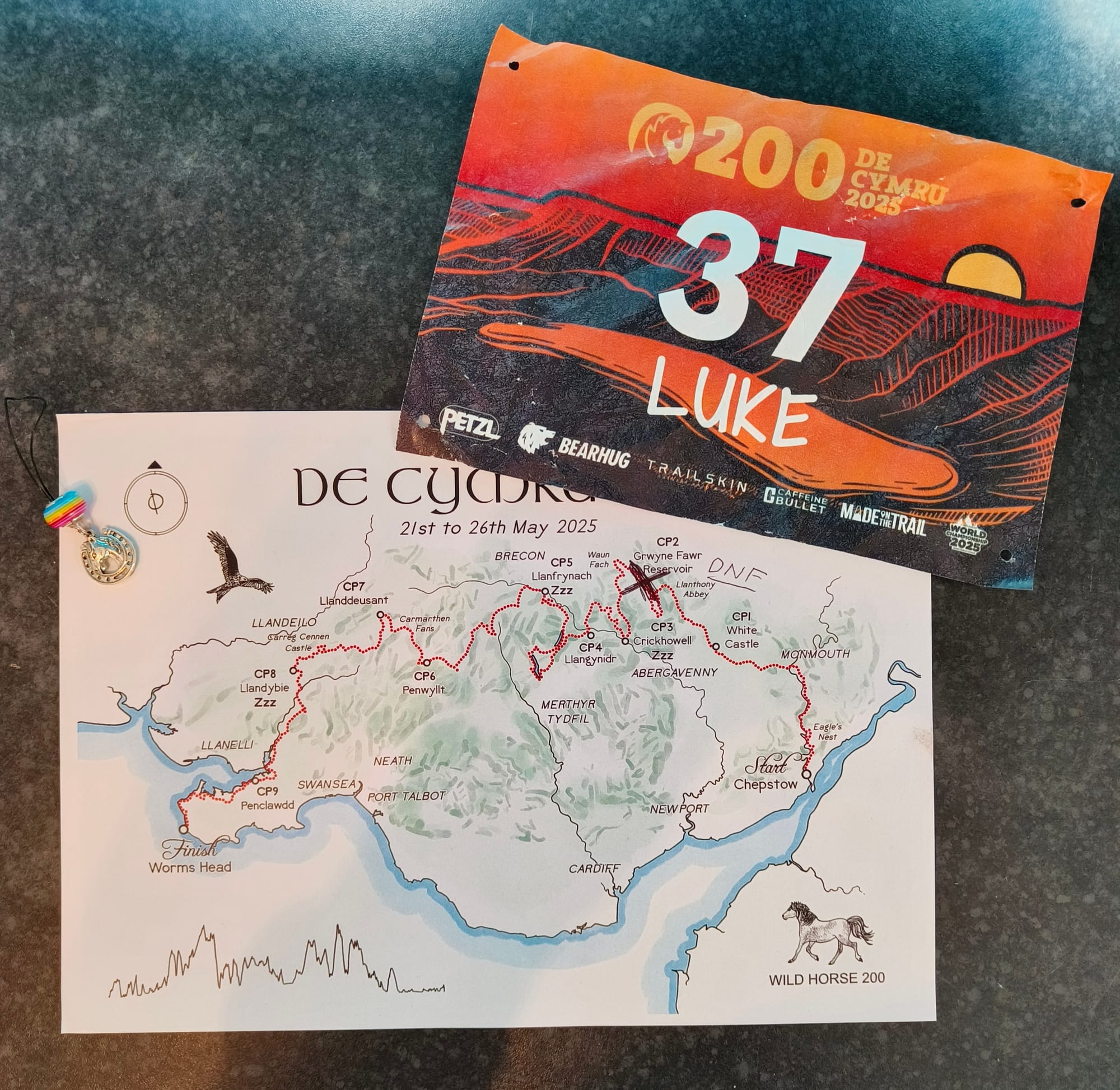
52 miles completed, 148 left untouched.
I've had such a mixed set of feeling about this DNF. Overwhelmingly though it has felt like a load has been lifted. The preparation for this race really took it's toll on me mentally, it wasn't healthy for my obsessive, anxious mind.
By the time I reached that start line my "why" wasn't strong enough, I had lost the passion for it. Whereas in other races after getting to a checkpoint broken I would have rested, picked myself up and pushed ahead, in this one the drive wasn't there anymore.
Do I still want to tackle it in the future? Yes. However first I have something important to sort out.
In the past 5 races I've done I've been bitten by dehydration and heat exhaustion: at the Epona I had medics check me just before half way, at the EDDUM I had a death march similar to this one when my hydration messed up, the CANUM was hot and hit me hard the second half, the HOWUM I'd started to turn in the unusually hot day, and of course now in the Wild Horse.
I still can't confidently fuel and hydrate in hot weather, and one reason my morale took such a big dip in the Wild Horse was I thought I'd done everything right. This time it wasn't an intensity issue, I'd kept things sensible and slow, yet the dehydration still happened.
Moving forward, for the remaining races of the Slam, my primary focus will be to nail my fuelling. I've been told the VOGUM is expected to be during a heat wave so that's a good test of any new strategy I'm using. Then the EDDUM, my nemesis, will be the true make or break test.
I'll start by increasing my consumption to 1L/h fluids with 600mg sodium, trying to take most of my carbs as powder in the fluids with a snack on the side to get me to 70-90g carbs/h. Carrying 1L/h is challenging so I'm also looking for ways I can do that: using larger race vests, belts, front pouches etc.
I'll be looking at better heat acclimation too. I thought I did well on the lead up, lots of runs in the hottest part of the day, but it was clearly not enough. I've been told using a sauna 3 times a week is a good way to build resilience, as is wearing extra layers to simulate running in hotter conditions.
What Went Well
- Taking the first section gently, walking the climbs, floating the downs, treating it like a slow plod from the start with lots of good fuelling and hydration
- Stopping in shops along the way for more substantial food
- Active Root Electrolite worked well that first section: tastes like a weak squash, goes down easily
- Altra Mont Blanc Carbons in general did the job well: kept my feet feeling happy until the later stage. Lots of wiggle room for my toes, good neutral shoe that didn't tire my upper legs, fairly well cushioned
- Running with others: Courtney and Charles, Dan Morgan, Jamie and Janine. I don't think I would have made it to even CP2 without them
- Finally getting to run with the legendary Dan Morgan was a joy. He's a hero to me and a relentless animal of a person. Now I've see what the Wild Horse is like I hold him in even higher regard
- Bucket hat and Patagonia Capilene Daily t-shirt to help keep the heat at bay. Didn't feel overly warm like I do in my black Running Punks gear
- Sleep mask and ear plugs for the sleep stations worked wonders, could block out the world around me and rest
- An aid station checklist to work through before leaving CP1
- Having a well organised drop bag with gear and food broken down in different zip lock bags
What Could Have Gone Better
- Dehydration and heat exhaustion, again, and this time despite being smart and keeping the intensity low. Whatever I'm doing it's not working on hot days whatsoever
- Switching to plain water in CP1 was a big mistake, as was not having some electrolite sachets I could use when I realised the mistake later on the trails. I think at that time my body really needed salt and sugar to process the water through my system
- Altra Mont Blanc Carbons:
- The laces started biting and were hard to get comfortable with that thin though (I think the thin socks contributed to this mind). Lacing them loose helped, but that then caused blistering and toe bashing.
- The firmness of the midsole wasn't the best by the 50 mile point, wished for a tad more cushioning
- They let a load of debris into the shoe, had to take them off and shake them out a fair bit
- The thinner Feetures Elite Light socks contributed both to my toe bashing and lace biting. I'm moving back towards the Bridgedales as a thicker more protective sock
- Running vest size: the 12 litre Salomon Adv Skin was just a tad too small, especially as an uncrewed runner. In order to bring more water and back up supplies I'll need to invest in either a larger pack or more side storage like a belt
- Morale: I needed a stronger why and stronger motivation, much stronger, to last the full 200 miles. The difference between me and the folks still out there right now pushing to the end isn't that they didn't get issues, it's that they kept going regardless.
Lessons About The Wild Horse 200
- The real challenge is the distance between aid stations: 29 miles for the first one, 22 for the second. If you struggle, if you mess up your fuelling or don't have what you need, that is a LONG way to go before you get to address the issues and switch out using your drop bag
- From a morale perspective too, if you are on a slog of a death march, you will be hiking for hours on end before you reach that station
- It is beautiful, drop dead gorgeous, all along. I only saw 52 miles of it, but it was an amazing 52 miles to cover
- I thought I was ready, I was not. Not even close
- I need to do much more adventure running and more multi-day adventures
- I need to nail my fuelling in a sustainable way
- I'm quite used to pushing through race problems fuelled by cola and spite, but for something like a 200 miler I need to be better at addressing the problems so I can continue onwards.
Damage
- Small blister under my second last toe on my left foot, no real issue this one, have left it intact
- Big toes were sore from toe bashing due to the thinner socks and looser lacing
- Slight extensor tendon inflammation due to the laces biting
- Bruised ego
Thank Yous
As always a huge thank you to all the wonderful volunteers at the event, the race directors Rhys, Cerys and Nick, and the medics keeping everyone safe.
Thank you to those that came to support & the crews helping their runners (and many time other runs as well).
Thank you to everyone who messaged me support before the race, and after they saw the tracker flag up a DNF.
Next?
Simple:
- Nail my hydration, it's more important than any training volume I could be putting in right now
- Test it thoroughly at the VOGUM, PIGUM, EDDUM and RIDUM
- Decide whether to do the Wild Horse 200 in 2026 or 2027
